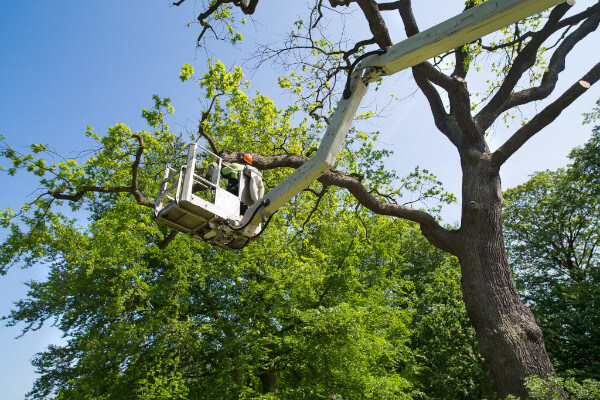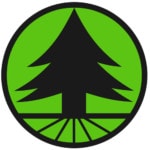Home » Articles posted by Brett Salles (Page 3)
Author Archives: Brett Salles
Tree Pollarding 101
Tree Pollarding 101 – everything you need to know about pollarding.
If you are looking for ways to keep your landscape and trees looking their best, several key methods can make a huge impact on how your outdoor space looks.
A process called tree pollarding can help to create a lush, beautiful landscape that promotes healthy trees.
Read on to learn more about pollarding trees and what the process entails.
Tree Pollarding Defined
Most people likely have never heard of tree pollarding, but it is an important part of maintaining healthy trees. The process involves cutting young trees and shrubs to the main stem or trunk to control their height.
The plants are not cut at ground level but instead are cut much higher at an average height of around six feet. This process helps to maintain the desired height for your trees while reducing shade and giving the trees a defined silhouette.
Many people opt for tree pollarding to keep taller trees from getting in the way of phone lines or electrical wires. It is also done to trees located close to a home or place of business to reduce the risk of branches breaking and falling onto the roof.
While most typical tree pruning processes remove the lower and crossing limbs of a tree, the pollarding process is a bit different. Pollarding trees is often done when the tree is dormant rather than when it is actively growing. Doing this while a tree is still young or dormant promotes fuller, faster, and greener growth.
In addition to protecting wires, structures, and promoting better growth, tree pollarding may also reduce the risk of fungus and pests. It can also help to protect your trees from various diseases.
How to Pollard a Tree
To pollard a tree effectively, it is best to leave the job to the professionals. They will start by cutting off the central leader of the tree first, then proceed to cut all of the branches around it that are at the same height.
By cutting the top of the tree this way, it shortens the crown of the tree. The gardener will remove lower limbs and any crossing limbs to promote a thicker crown as it grows back.
The younger the tree, the faster the new growth will return, while older trees may take longer to regrow leaves and new branches. By pollarding large young deciduous trees, ensures that they sprout healthily to achieve fuller, greener, and lusher growth.
Once the procedure is complete, most trees will produce “waterspouts” at the various locations where it has been cut. These areas will produce sprouts that should be removed at least once per year or every other year. Eventually, knobs or knuckles will form at these locations and continue to regenerate each year.
The timing of tree pollarding is critical and should be performed during the tree’s dormant season. If the tree is pruned during its growing season, it can stunt the growth, remove its energy source, and inhibit the tree’s ability to re-sprout.
Most tree pollarding is done during the fall or winter months of the year when trees are losing their foliage. This is extremely important because most trees rely on their leaves to help produce energy for healthy growth during the warmer months of spring and summer. Removing sprouts and pollarding too early in the year can cause the tree to stop growing, or even worse – to perish.
A Tradition of Pollarding Trees
Tree pollarding originated in Europe centuries ago, and the original method was done to ensure that more abundant, smaller branches were produced. As a result, these smaller branches were removed and used as fuel or for making items such as woven baskets.
As the branches were consistently cut back, farmers would harvest the slender sprouts and use them as a food source for livestock. These slender sprouts were also utilized to help weave small fences and other structures.
Today, pollarding fruit trees is a popular method to ensure healthy growth. When the tree is pollarded correctly, it encourages more production of fruits for a bountiful harvest.
Many urban areas choose to pollard trees that line busy streets to help control their growth, preventing branches from falling onto power lines and roadways. Cutting trees back can keep them healthy while maintaining them at a smaller, more easily manageable size.
The difference between topping and pollarding trees is that tree pollarding produces large knuckles. These knuckles are the source of new growth each year and can help to ensure that the tree continues to grow healthy in the future. Imagine the knuckles on a tree as large scars that heal while new growth re-sprouts from dormant buds during the springtime.
Topping a tree does not lead to knuckle formation. This process cuts the entire top of the tree off, resulting in a large wound that can cause the tree to die. Ideally, pollarding fruit trees and other species is best to ensure a healthy outcome.
Pollarding: A Unique Technique
Whether you want to encourage healthy growth or remove threatening branches, tree pollarding is a wise way to go. This unique tree-pruning process will ensure that your trees look lush and beautiful for years to come.
Always consult with a professional arborist or landscaper if you are considering using tree pollarding as a method to ensure best results.
For more information about our services or to find out more, contact us today.
Article was written by Conner D.
Article Source: https://www.graftingardeners.co.uk/tree-pollarding-101/
Did you miss our previous article…
https://www.treesforeducation.com/?p=284
WHAT TO AVOID IN HIRING A TREE TRIMMER
So you’re in need for a tree service company? Our recent What to Look for in Hiring a Tree Trimmer guide is meant to highlight features of a tree contractor that are positives — aspects that you should look for in any company that you are considering working with. This article, on the other hand, is the opposite. It’s full of red flags! If any tree contractor has these features, then stop, and keep looking.
INCOMPLETE INSURANCE
People get insurance for their protection and also for others. The same goes for businesses. The first and top item on this list is to avoid tree contractors with incomplete or no insurance. What constitutes “complete” insurance? Due to the dangerous nature of the tree service industry, a combination of different insurances is needed to safely operate a company. But the two most vital ones are the following.
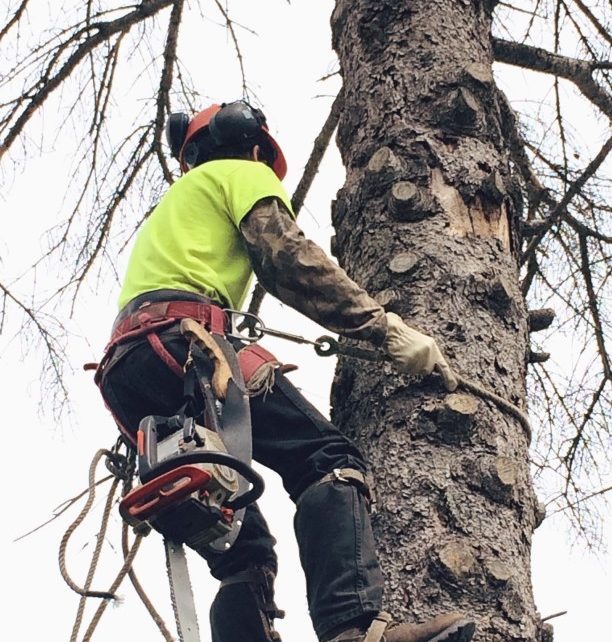 General Liability Insurance – This type of insurance is crucial for any tree service because it provides foundational business protection. It can cover property damage and bodily injury performed on jobs. Meaning, if a tree trimmer accidentally damages your roof, this is the insurance that would help with the repair. Without it, the consumer or property owner could be held liable.
General Liability Insurance – This type of insurance is crucial for any tree service because it provides foundational business protection. It can cover property damage and bodily injury performed on jobs. Meaning, if a tree trimmer accidentally damages your roof, this is the insurance that would help with the repair. Without it, the consumer or property owner could be held liable.
Worker’s Compensation Insurance – When the tree service industry is one of the most dangerous lines of work, you, as the consumer, NEED to hire a company that has worker’s comp insurance because this is what covers employee injuries. However, not all worker’s comp coverages are created equal. Worker’s compensation is extremely expensive! So, it can be very tempting for a tree service company to completely neglect it OR to classify themselves as landscapers in order to maximize their profits.
According to WorkersCompensationShop.com, the average rates in California for tree pruning employees range from 12.58-43.53%. This means that for every $100 that an employee earns, the company has to pay up to $43.53 in worker’s compensation. Just to give an idea of how significant that rate is, clerical office employees have an insurance rate of 0.36-0.99%.
Landscapers have an average insurance rate of about 11%. Due to workplace similarities, arborists may try to designate themselves as landscapers to take advantage of lower insurance rates. The difference, however, lies in the amount of coverage. Landscapers are able to perform tree work but are limited to typically 12 feet. Therefore, if a tree trimmer disguised as a “landscaper” with their insurance company gets hurt when 20 feet from the ground, their insurance will not cover the employee’s injuries. As a result, the property owner will be held liable.
UNLICENSED
Never hire an unlicensed tree service contractor! It’s a plain and simple rule.
For any tree service company, acquiring a contractor’s license with the state is a lesson that should be taught in Managing a Tree Service Company 101. As a general rule of thumb, you can expect any large or reputable tree company to already be licensed. A tree service company simply wouldn’t be able to grow to such a large status without it. However, if you come across a one-man operation, it would be a good idea to verify their license.
To learn more about why licensed tree contractors are the only way to go, please visit our What to Look for in Hiring a Tree Trimmer article for more information.
HIGHLY-DISCOUNTED COUPONS
We’ve all seen them. Coupons for 25% off! 30% off! Who doesn’t love a good coupon? And what’s not to love? Coupons work great for shaving some dollars off of a pizza order or new shoes. Those are items that typically do not cost thousands of dollars. Tree services, on the other hand, will generally cost well over $1,000.
Due to the hazardous nature of the tree service industry,  expenses are high and profit margins are low. It makes it difficult for any arborist to offer a large discount of more than 25% off. Let’s break it down. A tree company has a net profit margin of 15% (which for the arborist industry is considered to be very good). That means that after all expenses are paid, such as payroll, insurance, and gas — only 15% of revenue is left. This company quotes a customer $1,000 for a tree pruning. But wait! This particular customer has a 30% off discount coupon! That’s a whopping $300 off — leaving the business with only $700 left for wages, truck payments, gas, insurance, dump fees, etc.
expenses are high and profit margins are low. It makes it difficult for any arborist to offer a large discount of more than 25% off. Let’s break it down. A tree company has a net profit margin of 15% (which for the arborist industry is considered to be very good). That means that after all expenses are paid, such as payroll, insurance, and gas — only 15% of revenue is left. This company quotes a customer $1,000 for a tree pruning. But wait! This particular customer has a 30% off discount coupon! That’s a whopping $300 off — leaving the business with only $700 left for wages, truck payments, gas, insurance, dump fees, etc.
The only way an arborist would be able to offer such a hefty discount is if they mark up the standard market rate for a particular service in order to make up for the loss in revenue from the coupon. This is what price gouging looks like. You need your large tree trimmed. Other companies would quote roughly $2,000. But you don’t even bother getting multiple quotes because you found an awesome coupon in a local coupon book for 30% off of tree trimming services! So why look elsewhere? You’ll be saving hundreds of dollars with this coupon! This tree service company that you contacted tells you that it would normally charge $3,000 — but since your coupon shaves of 30% — your estimate now comes to $2,100. So as you see, it still falls into the same ballpark as the other companies without the coupon.
You may wonder why all of that matters? Well, what happens next time you need your tree trimmed, but you don’t have a coupon. Will they still offer you a deal? Or is their quote going to be significantly higher? Does it mean that you’ll need to spend more time again trying to figure out what tree service company to use AGAIN? Once people find a tree contractor that they like — whose work and people they trust — they tend to stick with them. Why spend all that time researching different companies and meeting with multiple estimators, when you can just go straight to the one you know?
In addition, it’s important for you to feel like you can trust your tree service company. Discounting overinflated prices is a common sales technique that many businesses use, especially in the product-based sector. It’s a pricing strategy that is effective in moving a consumer towards a purchase because they feel like they are getting a good deal — until they do a little more research and realize that their “good deal” is in line with other quotes.
POOR CUSTOMER SERVICE
The tree service industry is filled with a wide array of characters. Some companies consist of administrative personnel and field staff. And when you have your in-person estimate, you will typically be meeting with an estimator or project manager, whose job is solely customer service. So you can expect them to be professional and have strong interpersonal skills.
On the other end, some companies are a one-man show. When you have your initial visit for an estimate, you’ll be meeting with your actual tree trimmer. Tree trimmers climb trees with chainsaws and drag brush for a living. They don’t mind getting dirty and minor injuries tend to not faze. Their goal each day is to not only do a great job with the trees they’re working on, but also quite frankly— to not die! Customer service is secondary. So sometimes, you may not get the best customer experience throughout your entire journey with this particular “contractor”.
This doesn’t mean that all one-man operations provide menial customer service. Even LC Tree Service had to begin somewhere. Some of these small companies are run by great people who are highly proficient at what they do. So whether you’re dealing with a single person or a large enterprise, it’s important that you have good interactions. Do you feel that your trees are in good hands? Do you feel like your requests were heard and will be taken care of? Do you feel like you can trust the individual and the company? If you don’t, then you should look elsewhere.
LET’S SUMMARIZE
AVOID A TREE SERVICE COMPANY THAT:

LOOKING FOR A RELIABLE TREE SERVICE COMPANY?
LC TREE SERVICE WOULD BE HAPPY TO HELP!
619.677.5777
The post WHAT TO AVOID IN HIRING A TREE TRIMMER first appeared on San Diego Tree Trimmers – LC Tree Service.
Did you miss our previous article…
https://www.treesforeducation.com/?p=279
10 MOST COMMON FLOWERING TREES IN SAN DIEGO
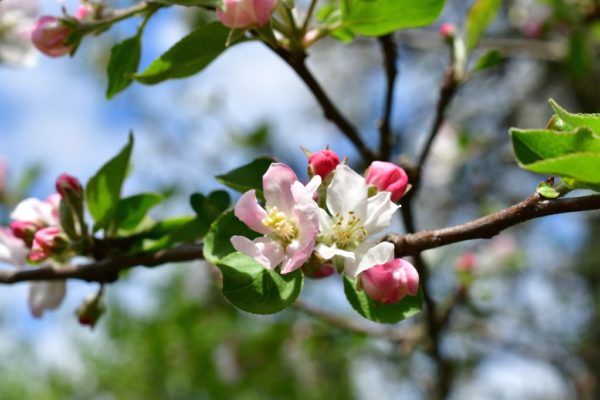

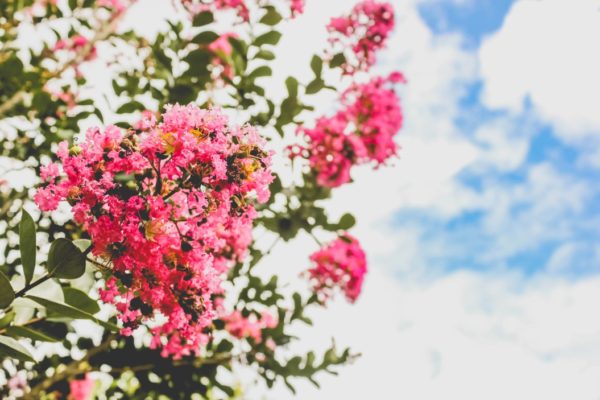
Spring season is that wonderful time of the year when colorful blooms begin to flourish throughout many parts of the world. But in the city of San Diego, we have the luxury of being able to enjoy flowering plants and trees all throughout the year due to our mild and sunny climate. In fact, many landscapers and property owners strategically plan their landscape so that there is always a flowering plant or tree from winter through autumn. As one tree’s flowering season ends, another one begins.
Whether you’re looking to add a flowering tree to your property or just plain curious, we’ve compiled a list — in no particular order of popularity — of what we consider to be the most common flowering trees in San Diego.
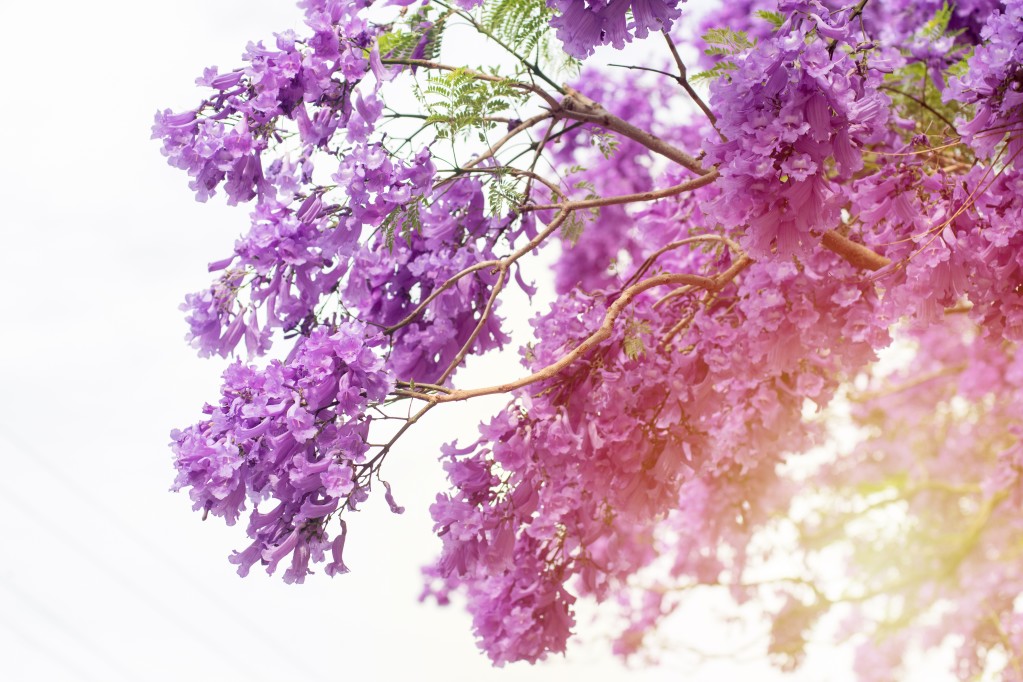

1
JACARANDA
Jacaranda mimosifolia
Jacarandas are one of San Diego’s most spectacular flowering trees. In late spring into the summer months, it’s hard to go a day driving through town without seeing at least one jacaranda and its popular lavender, bell-shaped blooms. These flowers grace us with their presence for two months before falling and creating a carpet of color on the ground beneath.
When not in bloom, the jacaranda is still one of San Diego’s finest-looking ornamental trees. Once established, it’s a fast-growing tree that develops a bright green canopy of fern leaves against the tree’s grayish-brown limbs. It grows fast, but its size at full maturity is quite manageable because it typically only grows to roughly 25 to 40 feet in height, with similar dimensions in canopy spread. The jacaranda is also a popular choice with urban planners due to its “pavement friendly” roots, which, unlike some other common trees like the ficus benjamina, is less likely to damage sidewalks and streets.
There are many wonderful features associated with the jacaranda, but even this beauty can’t be perfect in all aspects. Unfortunately, the jacaranda is a deciduous tree, which means that it loses its foliage every year. So for the winter months, you’re left with an arrangement of bending grey wood in your outdoor space. But hey…neutral colors are all the rage…so apparently it works. As the weather begins to warm up, the tree’s foliage slowly fills the canopy with yellowish-green leaves. It looks sparse and a little sickly, depending on the tree. Not very appealing, to say it nicely — but when the warmest and sunniest season arrives, the jacaranda’s beauty shines once again with its lush green canopy, followed by its magnificent purple blooms.
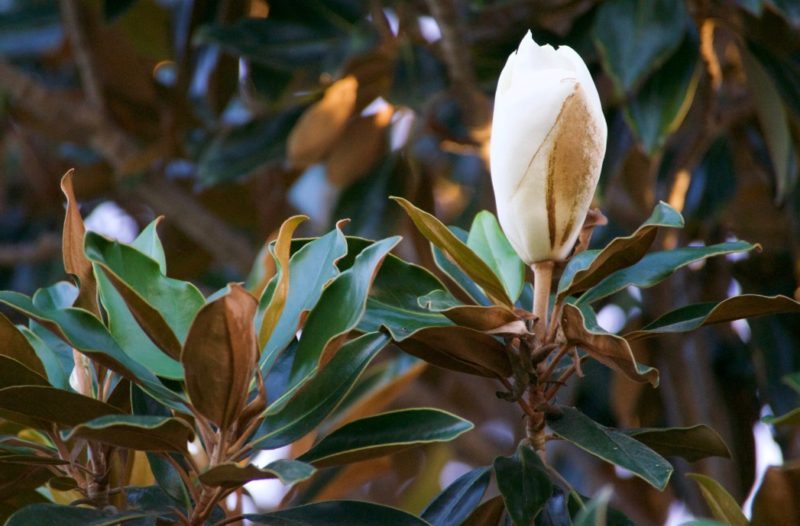
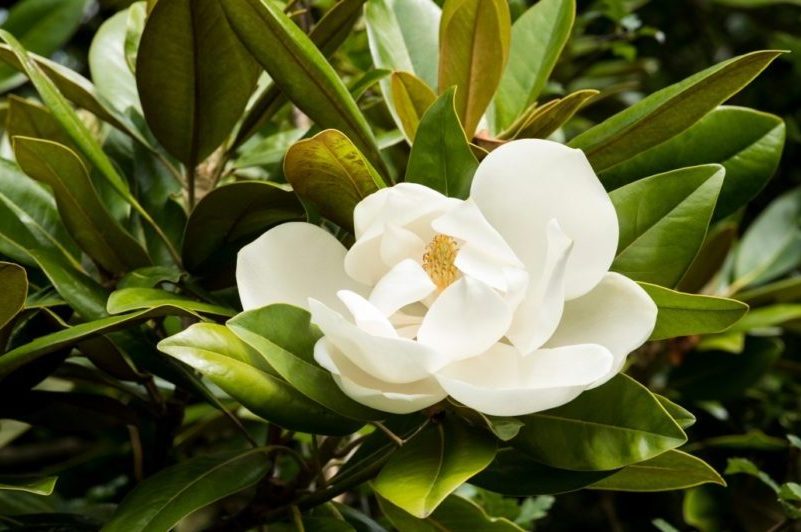
2
MAGNOLIA
Magnolia grandiflora
The magnolia tree is a very well-known name in the flowering tree category. For all you home decorators, think Joanna Gaines and her popular Magnolia Homes company. But what many do not know is that it is also the most ancient flowering plant that we know of according to fossil records. Surviving through ancient history, there are more than 200 magnolia species that originated mostly in Asia and in the Americas. They are common trees throughout the world, especially in sub-tropical and tropical regions, and are known for their stunning flower display with pink, purple, white, and even yellow blooms.
The most common magnolia in Southern California is the Southern magnolia. It possesses large evergreen leaves that exhibit a deep green color and a unique brownish touch. Then in the late spring and into the summer, the Southern magnolia unveils its beautiful, large, white flowers that contrast so well against its green foliage backdrop. When we say large, we mean large, as the oval-shaped leaves typically range from 5-8 inches in length, and its fragrant flowers possess an 8-inch diameter range.
Compared to the other popular flowering trees on this list, the Southern magnolia is a rather slow-growing tree and is known to take up to 10 years after planting to even blossom. So patience is required! But it won’t stay little forever. It typically matures to a height of 60-80 feet with a canopy spread of roughly 40 feet, and in its most ideal conditions, it even grows taller than 80 feet!
When it comes to trimming a magnolia tree, great news! They don’t require much. But the bad news is that these trees are FINICKY! Trim your tree at the wrong time of the year, and you can kiss the next year’s beautiful flower display goodbye. Even worse, given the right candidate, you could end up killing your tree. Magnolias, especially mature ones, tend to have a hard time recovering from injuries. The best time to trim them is right after its flowering season so that it has sufficient time to heal before winter. Otherwise, trimming a magnolia during the wrong season can result in excessive bleeding, which could weaken the tree and leave it vulnerable.
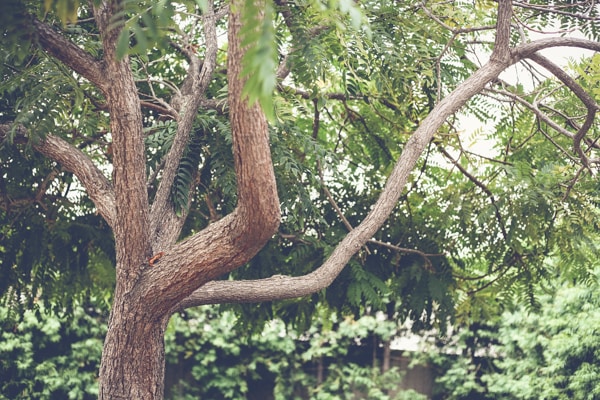
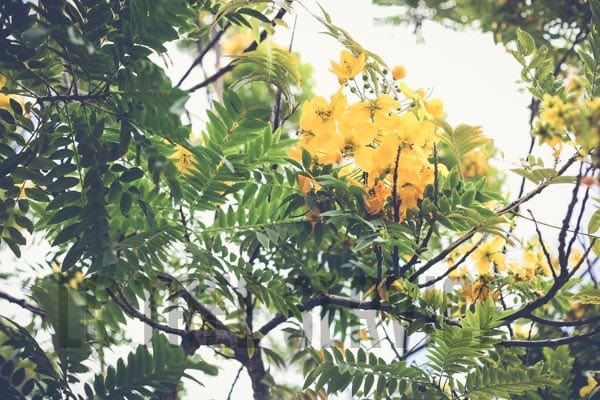
3
TIPUANA TIPU
Tipuana tipu
Native to South America, the Tipuana tipu, or tipu for short, is one of San Diego’s most popular trees. When not in bloom, it can often be mistaken for the jacaranda, since the two have very similar structures and fern-like foliage. Even arborists, at a distance, may need a moment to determine who’s who. However, once its sunny yellow flowers emerge in the spring and into the summer, there’s no mistaking the two trees.
With its roots in a tropical homeland, the tipu thrives in areas with plenty of warm sunlight, so make sure to plant it in a location with full sun. It loves the heat and can handle San Diego’s hot and dry summers extremely well. This is why it is also a popular choice for desert communities.
The tipu is a choice selection for properties and urban development throughout San Diego due to its rapid growth, pavement-friendly roots, drought resistance, and flowery display. It’s perfect for all you impatient folks who don’t want to wait 10 years for their newly-planted young tree to provide ample shade and a majestic presentation. And even better, if you’re not interested in a huge tree, the tipu is a great choice, as they are medium-sized trees that are usually seen in the 30-50ft range with a wide canopy spread that matches its height.
The Tipuana tipu is a fast-growing tree that typically grows 2-3 feet a year! A young tree has the potential to quickly develop a canopy width of 20 feet just a few years after being transplanted. Due to this rapid growth, it’s important to keep your tipu on a regular trimming schedule. Otherwise, the tree ends up looking like an unkempt child with neverending bedhead. But when properly trimmed, the tipu has the potential of looking amazing — whether it’s covered with yellow blooms or not!
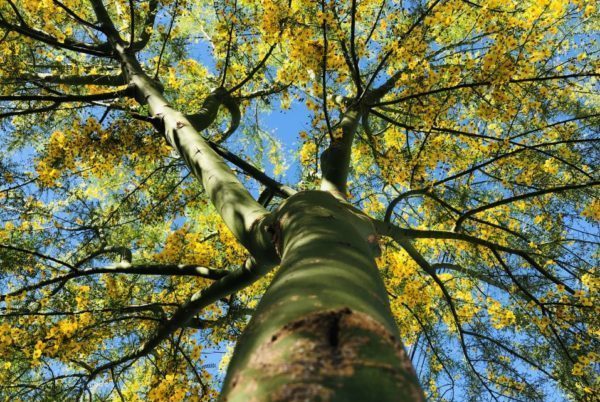

4
PALO VERDE
Parkinsonia florida, Parkinsonia microphylla, Cerdium ‘ Desert Museum’
The palo verde is another common yellow-blooming tree in San Diego. The name in Spanish means green stick because, as you can guess, it possesses limbs that are green! It’s a unique sight, especially with its yellow blooms that complement the green so well. As the palo verde matures, its trunk and mature branches eventually turn brown, but any new limbs grow out green. Why green? The bark of the palo verde is uncommonly filled with chlorophyll, which allows it to participate in photosynthesis — a job that is normally assigned to the leaves. But for this green wonder, its foliage only contributes one-third of the tree’s food.
Even with its unconventional green limbs and showy flowers that allure people, the palo verde is still one of those trees that you either love or hate. It’s actually a tree that tree trimmers can’t stand! Why? Because these trees are notorious for pain! Yes, their green branches are awesome to look at, but with close examination, you’ll realize that they’re covered with sharp spikes. It’s a desert tree, and it seems to have copied the same spiky qualities of its desert best friend (the cactus, of course). It’s like middle school cliques dressing the same. “Make sure to wear your spikes on Friday!”
As with any tree, one of the palo verde’s goals is reproduction. No harm there. However, this tree is like the “rabbit of the tree world.” Palos love to procreate, and they’re good at it. If left unmanaged, a single tree on a property can multiply into a grove of more than 20 palo verdes in less than 10 years. Also, the tree’s cute and innocent-looking babies don’t go without a fight. Remember those spikes? If you simply go in to pull a baby palo out with bare hands, chances are you’ll get stabbed. It is best to carefully pull at the base where spikes tend to not grow or to use pliers.
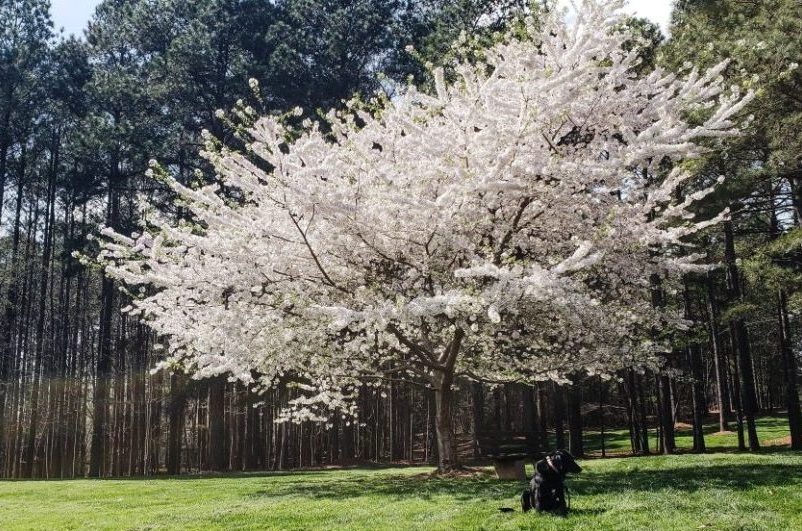
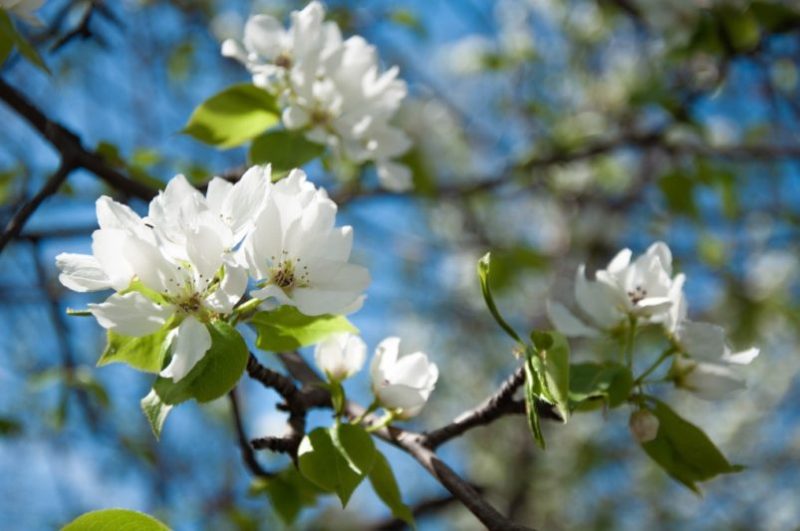
5
EVERGREEN PEAR
Pyrus kawakamii
Native to Taiwan, the evergreen pear is one of San Diego’s standout trees. Is it because it produces a vibrant colorful display of flowers like other trees on this list? No. Does it have delectable juicy pears to eat? No, again. So what’s so special about the evergreen pear? While this tree doesn’t boast of colorful springtime blooms or delicious fruit to eat, it “sticks out of the crowd” due to its distinct flowering season. In the winter, when other trees, like the jacaranda and palo verde, are plain and bare, the evergreen pear showcases its large clusters of white blossoms. It’s a wintry display that’s very appropriate to the season. We may not get snow in the streets of Downtown San Diego or our famous Balboa Park, but we get snow-white laden trees!
The evergreen pear, despite what the name implies, is not an evergreen. It is called an evergreen tree because it has a very short dormant period, causing some people to label it semi-deciduous. In the fall, its foliage morphs to an orangish-red, which drops shortly afterward. Fortunately, it only stays bare for a short period because soon afterward, its canopy becomes engulfed in showy white blooms through the rest of the cold winter season. Then at the end of winter or stretching into spring, the flowers fall to the ground and create a lovely frosty carpet.
The evergreen pear tree — despite its name — does not produce sweet pears for people to eat. Instead, it grows little, brown, inedible fruit that can create a messy nuisance during drop season.
So to sum it up — the evergreen pear is not an evergreen tree, and it doesn’t produce edible pears. Evergreen pear. Just a bit of a misnomer…just a tad.
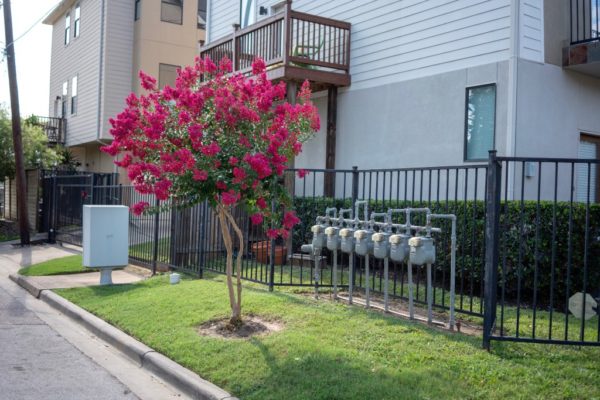
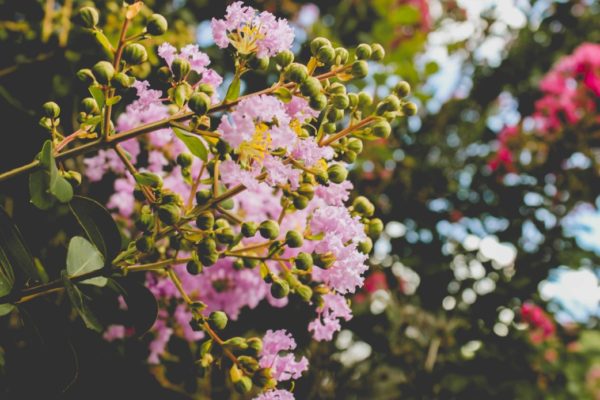
6
CRAPE MYRTLE
Lagerstroemia
The crape myrtle tree, also spelled crepe mrytle, is one of San Diego’s most beautiful flowering trees. It’s a dainty little thing that can be found in different varieties with differing height potentials. It ranges from the “very dwarf” varieties that only mature to a range of 1-3 feet to the regular-sized crape myrtles that “soar” to 20 feet. Then there are the varieties in between — dwarfs, semidwarfs, and small. Crape myrtle trees possess colorful flower clusters available in red, pink, lavender, purple, or white. These fragrant flowers grow in puffy clusters that end up dominating the tree’s canopy in the summer and create beautiful displays in San Diego’s landscape.
The crape mystle’s origins take root in China, where it was named “Pai Jih Hung” — meaning hundred days red. Why? Because the crape myrtle has an amazingly long flowering season that lasts 3-4 months! Quite impressive when you consider that the jacaranda tree’s bloom season lasts 2 months, and the magnolia’s flowers appear for a whopping 7-9 days! While the tree was originally named after its long bloom season, here in the United States, it derived its name from the crinkly appearance of its flowers, which resemble crepe paper.
Aside from its stunning display, the crape myrtle has other features that make it a great tree to add to your property. It is unfazed by the hot summer days and drought conditions. But make sure not to test your crape myrtles heat and drought endurance until its roots are well-established. This tree loves the sun, so also make sure to plant it in an area that receives plenty of sunshine. Otherwise, you may have to miss out on its colorful blooms, as it may not produce flowers if it doesn’t receive enough direct sunlight.
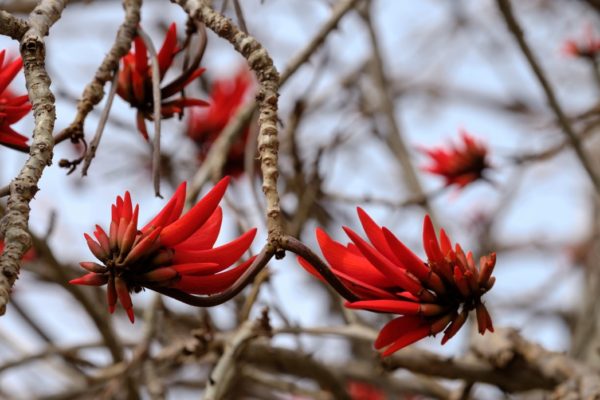
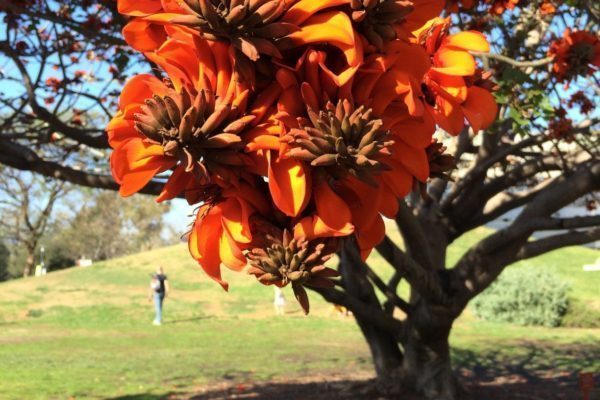
7
CORAL TREE
Erythrina
This next tree shares a striking resemblance to ocean corals. We’re talking about the coral tree, of course — a common and fitting sight for beach-loving San Diego. With roughly 130 species of coral trees (Erythrina), this is a popular tree, not just in California, but in temperate, subtropical, and tropical zones worldwide. It even happens to be the national flower of Argentina and Uruguay.
While many coral trees love the tropical heat (as you can see from their places of origin), quite a few do well in San Diego’s semi-arid climate. About a dozen Erythrina species call San Diego home. These include the naked coral from Mexico, the coastal coral and Tambookie thorn coral from Africa, and the Erythrina x sykesii from Australia. And as heat-loving trees, you might have guessed that coral trees require full-sun exposure to thrive, so make sure to plant accordingly, and don’t worry when it gets over 100° outside. Your coral tree is in “sunshine buffet heaven.”
Our local coral trees are distinguishable by their long, thick secondary branches that stem from a SHORT trunk. Some trunks are so short that they seem to barely rise up out of the ground. But just because it posses a short trunk, it doesn’t mean that the rest of the tree stays short, as it has an average height of 20-40 feet and a wide canopy width of 40-60 feet.
When the tree’s branches start at a low point, it looks like the perfect climbing tree for children. But it’s actually deceiving because the coral tree is notorious in the tree service industry for its susceptibility to breakage and tree failure. This is due to its brittle wood, poor structure, and tendency to form included bark, which is basically a weak junction between two limbs that is prone to splitting given the right amount of pressure. So the coral tree is definitely not the tree you would want to build a treehouse in or hang a swing on. Not to mention, some species also have thorns protruding from their trunk and stems.
Now to the flowers. The coral tree’s blooms are in a class of their own. With their fiery-red color and finger-like appearance, the name Erythrina actually stems from the Greek word for red — erythros. Most Erythrina species develop large, red flowers, but some also display deep orange blooms. When most flowering trees in San Diego flaunt white, yellow, or soft hues of pink or purple, the coral tree’s brilliant red makes this tree’s flower presentation an exotic attention-grabber. You can also see its blooms earlier than other trees due to the coral tree’s tendency to display its flowers in the early spring, as opposed to late spring, like most of the other flowering trees in San Diego.
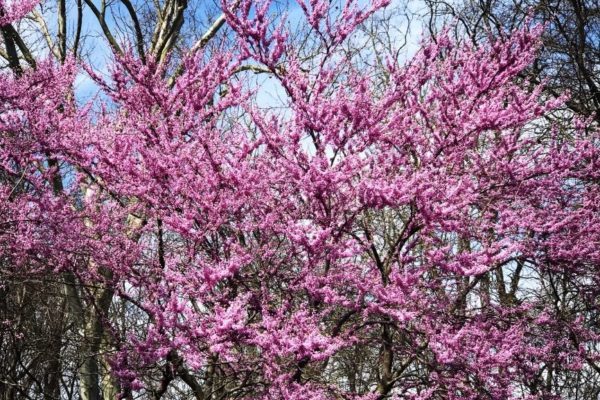
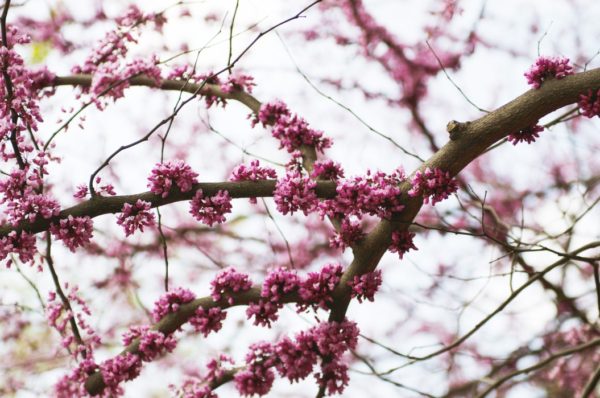
8
WESTERN REDBUD
Cercis occidentalis
Some flowering trees, such as the magnolia and mimosa trees, still retain a good portion of their foliage during bloom season. Other trees become immersed in blooms. The Western redbud is one of those trees. In the spring, hordes of purplish-pink flowers sprout all along the tree’s limbs which last for 2-3 weeks.
There are over 10 redbud species throughout the world, but only two are native to North America. As you may have already guessed, the Western redbud originates from the American Southwest — more specifically from southern Utah, Nevada, Arizona, and California. In fact, it has even been named the California redbud, as it’s a native tree that you can find in canyon bottoms, creeks, and other areas with moister soil in California.
Growing to a height of only 10-20 feet and 10-15 feet wide, the Western or California (whichever name floats your boat) redbud is a great choice for anyone desiring a small tree with pastel-colored blooms. This truly is a springtime tree because unlike many of San Diego’s other flowering trees that hold onto their blooms until summer, the Western redbud typically only possesses its flowers from March to May. It really does scream, “Springtime is here!” with its showy flaunting of pink and purple hues.
The Western redbud is a tree that loves the seasons. In the spring, it bedazzles us with its lovely flowers. Then it drops its blooms to make way for its green, heart-shaped foliage, all ready to soak up the hot sun in the summer. In the fall, the green foliage transforms into comforting autumn colors, which eventually drops toward the end of the year to expose a naked “winter-looking” tree. But be patient, because like clockwork, when the first month of spring comes around, so will those charming blooms!
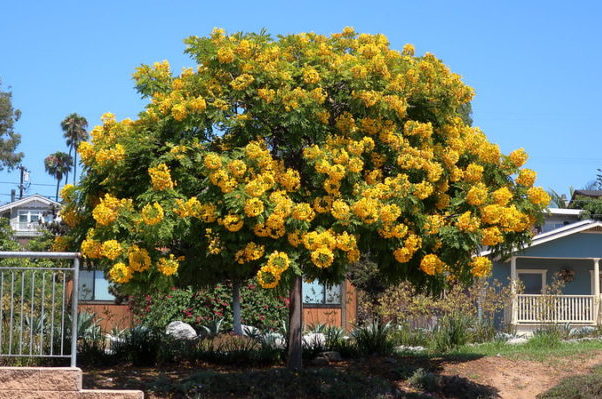
Photo credit: cultivar413

9
GOLD MEDALLION TREE
Cassia leptophylla
The gold medallion tree showcases an explosion of yellow pom-poms during San Diego’s summer months. With its basketball-size flower clusters growing on the ends of its limbs, it truly does look like an explosive fireworks display!
Stemming from Brazil, this is a tropical tree that does best in tropical climates, but still manages to flourish in San Diego’s dry climate. If you’ve visited some of the tropical regions in the United States, the gold medallion probably reminds you of some of the trees from those states. That’s because it has two very popular cousins — the golden shower tree that is so common in the South and the rainbow shower tree that populates the Hawaiian Islands. Both have amazing flower spectacles and so does the gold medallion tree! It’s a family trait.
The gold medallion is a fast-growing tree that sprouts to about 20-25 feet in height, with an average canopy spread of 20-30 feet that is composed of long compound leaves. Being a tropical tree, it does well through San Diego’s heat spells and requires a planting location that receives full sun. After being translated, the gold medallion will require a frequent water schedule until its roots become well-established. Then it will require less water and will tolerate drought conditions very well.
Like other common flowering trees in San Diego, the gold medallion is a member of the legume family, so after the flowers drop, LOOOONG brown seed pods that can grow to about two feet in length begin to take over the canopy. Not too pretty of a sight when you see a populace of brown seed pods dangling from a tree, especially when that tree was looking quite dapper with its green foliage and showy yellow blooms just a few months prior — but beauty is fleeting.
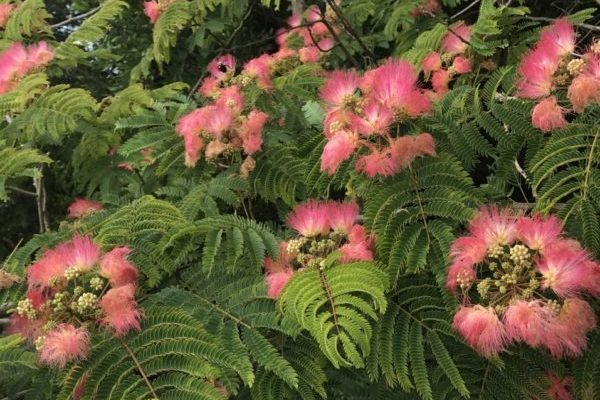
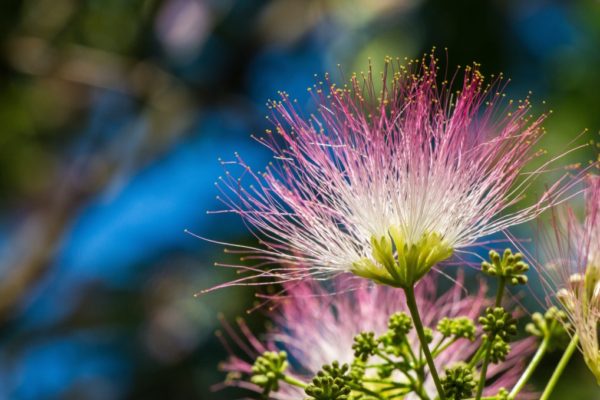
10
Albizia julibrissin
If you like the sight of hummingbirds, then the popular silk tree, also known as the mimosa tree, would make a great addition to your property’s landscape. Hummingbirds, bees, and butterflies absolutely love this tree’s uniquely-shaped, pink blooms. And even better, property owners love this tree for its total package. This is a tree that is not only stunning when it’s in bloom, but it’s also extremely hardy, fast-growing, and easy to care for.
Originating from China, the silk tree was brought to the United States in the mid-18th century, and now can be found in most states from coast to coast. It derived its name, silk tree, from its flower puffs that resemble silk threads. If you have ever traveled to Hawaii, this is a tree that brings a sense of familiarity because it looks nearly identical to its cousin, the monkeypod tree, which reigns as one of Hawaii’s most prominent trees. The silk tree possesses a tropical display and does very well in high temperatures. While it may not be the tropics, it still flourishes in the dry, hot summer months in San Diego. It may be a heat-tolerant and drought-tolerant tree, but being a tropical tree, if you want your mimosa to reach its highest potential, then it would be best to keep it on a regular, deep-water schedule.
In the late spring and into the summer months, the mimosa tree shifts into “bedazzle” mode when its pink blooms emerge. Unfortunately, as the saying goes, “All good things must come to an end.” It holds true with the silk tree. After its beautiful bloom season ends, the tree’s “ugly” season begins, as its gorgeous art show turns into a sad exhibit of 6-inch seed pods. Initially, it’s not too bad, but then the tree’s fern-like foliage drop when the temperatures begin to drop. Then in the winter, all that is left is a straggly, leafless tree with hundreds of drooping, brown seed pods.
As with any tree, when the silk tree is first planted in a new location, it goes through a shock period that can last a couple of years. You won’t see much action during this time. You won’t even see flowers. But once its roots get firmly established (typically 2-5 years), the tree quickly grows until it reaches its plateau height, which typically lands in the 20-30ft range. And after years of waiting, you’ll finally get to see those spectacular flower clusters. But before that happens, the tree needs to reach a certain level of maturity before it can produce flowers. In general, the mimosa typically doesn’t start producing blooms until it reaches a height of 10 feet.
LOCAL SAN DIEGO NURSERIES
Evergreen Nursery
Armstrong Garden Centers
Moon Valley Nurseries

NEED TREE TRIMMING OR REMOVAL SERVICES?
LC TREE SERVICE WOULD BE HAPPY TO HELP!
619.677.5777
The post 10 MOST COMMON FLOWERING TREES IN SAN DIEGO first appeared on San Diego Tree Trimmers – LC Tree Service.
WHAT TO LOOK FOR IN HIRING A TREE TRIMMER
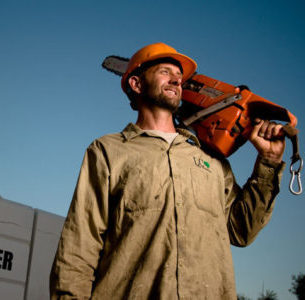


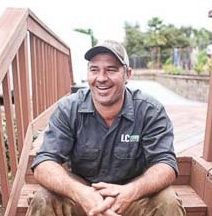

People need the help of a tree service company for a variety of reasons, from a single tree on a residential property that needs a trim, to dozens of trees that need to be removed for a large construction project. Sometimes, you may also have a sick or infested tree that needs treatment, or you may also just require an arborist consultation or arborist report. Whatever the reason, it is important to choose wisely. Trimming and removing trees is extremely dangerous work. Unfortunately, trees get butchered and accidents happen. Trees can sometimes be unpredictable, and not to mention, tree trimmers are working on these towering limbs and trunks with running chainsaws! So what should you look for when hiring a tree service company for your property?
REPUTATION
Is the tree service company that you are considering hiring a reputable one? Do they have good reviews on third-party websites, like Yelp or Google? Yes, this may be biased towards new companies that haven’t had the time to build their online presence, since all companies, including ours, had to start with nothing to show. But when the market is saturated with so many tree care companies to choose from, it’s wise to choose one whose work many people have been pleased with, rather than one that doesn’t possess much of a reputation, so you really don’t know what outcome you’ll be receiving.
It is good to look for reviews outside of a company’s website since they tend to be more trustworthy. Sadly, not all reviews on a company’s website can be trusted as legitimate. We know this first hand because, on more than one occasion, other tree service companies have copied our website content onto their site, including our customer reviews. So, to make a long story short, look to verifiable reviews when you are trying to determine what company to use.
INSURANCE
Choosing a tree service company that is fully insured is one of the most important features that you must consider.
Fact 1. Trimming and removing trees is undeniably dangerous work.
Fact 2. Accidents happen.
If the tree service industry is so precarious, you would think that ALL tree companies would naturally have insurance. But lo and behold, many companies do not! “Why wouldn’t they?” you may wonder. Well, due to the dangers of the industry, insurance rates are extremely high. Some tree business owners simply do not want that high of an expense because if they did have insurance, it would cut drastically into their profits. Therefore, it isn’t always the best idea to settle with the lowest bidder, especially if there is a huge difference between bids.
Here is an example scenario. You need a tree removed, so you collect bids from three different tree care companies.
Company #1 quotes $3,000.
Company #2 quotes $3,500.
Company #3 quotes $1,200.
As you can see, the $1,200 quote that you received from Company #3 is drastically lower than the other companies. Too drastic of a difference! Yes, from a financial standpoint, it is the most appealing. But there is a hidden reason why they can afford to charge so little. It could be that they pay their employees “under the table,” so they don’t have the payroll taxes and all the other expenses that go hand-in-hand with payroll. It could be that they are inexperienced and unknowingly underbid the project — which will not result in a good outcome for them, but also for the customer. We’ll touch on that later in this article. It could also be that they are not insured, so consequently, they do not have the expenses that the other companies have to consider when drafting your quote. It could also be a combination of all the above mentioned. That is just a bad recipe for additional disaster if disaster were ever to hit!
What type of “disasters” could happen on a tree project? The most common mishap would be property damage. Sometimes, even with the most experienced and skilled companies, limbs fall in an unexpected direction, damaging whatever is situated below, such as fences, roofs, sprinklers, landscape, and hardscape. In the worst-case scenarios, a person can get injured or even fatally injured. If anyone is injured on your property, then you, as the property owner, could be held liable IF the injured worker was not covered by insurance. So, please ensure that any tree worker you contract to work on your property is properly insured as a safety precaution for everyone.
LICENSED
Ensure that you hire a tree service company with a license. We’re not just talking about a business license (which they should have also), but a contractor’s license with the state. When you hire a licensed tree company, you are hiring a company that cares to do things right. Would you want to hire a company that doesn’t care to conduct business legally? What does that say about the business owner’s ethics? Many people are not aware that when a business owner applies for a contractor’s license, they are required to be fingerprinted in order for a criminal background check to be conducted. This should give you, as the hiring party, some sense of assurance.
Of course, that’s not to say that all licensed contractors conduct business ethically or that unlicensed contractors all conduct business unethically. Many unlicensed contractors have good intentions to provide great service at the lowest possible price. But unfortunately, there is a lack of accountability. And, it is not unheard of for a contractor to unexpectedly disappear from a partially-completed job — usually because the project was underbid, and it ended up being more difficult or taking much longer than expected to complete. Then, the customer is left with an incomplete job and no contractor left to finish it.
Unlicensed tree trimmers also lack complete insurance. They may possess general business insurance, but in order to qualify for general liability insurance (which is what helps you and the company if property damage is incurred), workman’s compensation, and bonding, you must possess a contractor’s license. All of these precautionary expenses that tree care companies incur are hefty, hefty, hefty! So an unlicensed tree contractor who doesn’t need to deal with them has a huge cost advantage that enables him to provide the lowest bid compared to their licensed and insured counterparts.
AFFILIATIONS
If you have already done some shopping around for a tree service company to work with, you may have noticed that many companies list out organizations that they are registered with. You may have even recognized the same organization logos on different arborists’ websites and/or recognized similar organization initials, such as ISA and TCIA.
ABC…123…what do all these mean? And why should you care?
Hiring a tree care company that has industry affiliations is important because it demonstrates that the company:
- cares to grow in their field, as these organizations provide yearlong resources for learning.
- has a desire to network with other companies, which can help increase their accountability and reputation.
- cares about increasing their knowledge of business operations. This is vital because a business owner who cares about business operations cares about providing great customer service.
The most recognized national arborist organizations are ISA (International Society of Arboriculture) and TCIA (Tree Care Industry Association). A company may also have affiliations with groups outside of the tree industry but pertain to associated industries — such as property management groups, construction and builders groups, and business networking groups. Recognizable companies in San Diego, as well as nationwide, include BOMA (Building Owners and Manager Association) and BIA (Building Industry Association). Why would those non-arborists groups matter? Because if a tree service company has large property management companies and builders on their clientele list, then chances are that they deliver impressive outcomes and possess strong customer service that these companies continue using them.

CREDENTIALS
Now that you’re more familiar with industry affiliations, let’s move on to credentials. ISA, which is the leading arborist organization in the nation, is the same group that grants the credential of Certified Arborist. In researching tree care companies, you may have seen some promoting the title of Certified Arborist — or better yet, ISA Certfied Arborist.
Certified Arborist. ISA Certified Arborist. Is there a difference? No, they’re the same certification because ISA is the only organization in the nation that grants them. So a Certified Arborist is technically also an ISA Certified Arborist.
Hiring a Certified Arborist is different than hiring just any arborist, which is the title given to anyone whose work involves trimming and removing trees, and/or tree health care. Anyone can learn to trim trees through job experience, on-site training, and even through YouTube. But having the credential of being a Certified Arborist means the individual is trained and knowledgeable in all aspects of arboriculture. In order to be granted the title, an applicant must have a minimum of three years of full-time work in the tree industry. A formal exam must also be passed that covers the ins and outs of trees, including topics such as soil management, tree biology, safe work practices, and more.
KNOWLEDGE
Does the tree care company you are considering hiring for your project seem to be knowledgeable about their field? Not everyone in the arboricultural industry actually understands the science involved with trees. This is important because if you’re seeking to have a tree trimmed, for example, it’s important for an arborist to understand the impact that pruning has on trees. How much is a safe amount to prune off? How will trimming certain areas affect the tree’s future growth projection? What season is best or harmful for certain species? For example, if you find a tree trimmer who is open to trimming your pine tree in the summer — keep shopping! That person receives an F in Tree Biology 101! Pine trees should never be trimmed in the summer, and any arborist who knows trees would know that bit of rudimentary information.
Hiring a tree care company that also specializes in tree health care is a feature that is beneficial because:
- You may unknowingly have a tree infested with pests or infected with a disease that the company’s estimator may notice during your estimate.
- Early detection of an infestation or infection is key to saving your tree.
- Tree Health Care Specialists can easily detect signs of common pests and diseases in the area, so the proper diagnosis and treatment can be given.
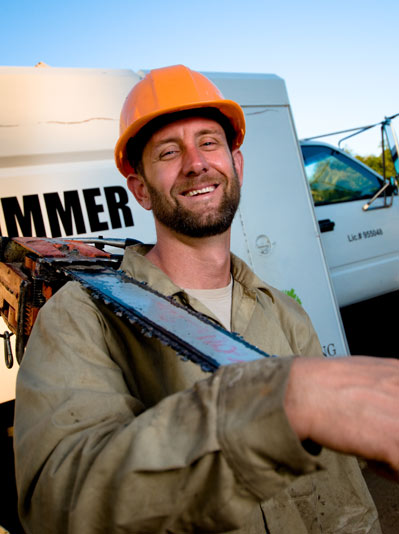
PROFESSIONALISM
Another important feature to look for in hiring a tree service contractor is the company’s professionalism. Do they present themselves professionally — as an actual business or more of a side gig or one-man show? You could say that this would be a valid “judge a book by its cover” scenario because how a company presents itself speaks volumes on how behind-the-scenes operations are handled. Some tree trimmers that you meet with for a quote may come across as gruff and/or dirty. Not so much of a surprise. It is a tough and messy job. And it doesn’t mean that just because the person you are meeting looks that way, they will do a poor job. Even LC Tree Service started off as a small, one-man show, but Founder, Larry Coalson — even as dirty as he was during estimates — still was able to provide outstanding work for his first set of customers.
If your tree estimator appears as though he just came from a job, it’s because he did. And not only did he already cut down some limbs and trees that day, but he also had to answer phone calls, return phone calls, reply to emails, draft invoices, dump the truck to prepare for the next day’s job, and maybe even do some equipment maintenance. As you can clearly see, this person is busy — not to mention tired — as working in the sun and carrying heavy loads for hours a day takes a toll on just about anyone. So when one person is handling the entire process or at least 90% of it, then it shouldn’t be a surprise when phone calls take a while to return or jobs take an extended amount of time to complete. While all companies could have the occasional slip-up in returning a call or email in a timely manner or take longer than expected to complete a project, companies that employ a team of field workers and administrative staff tend to be more efficient in their performance and customer service since they have more people to help carry the load.
CUSTOMER SERVICE
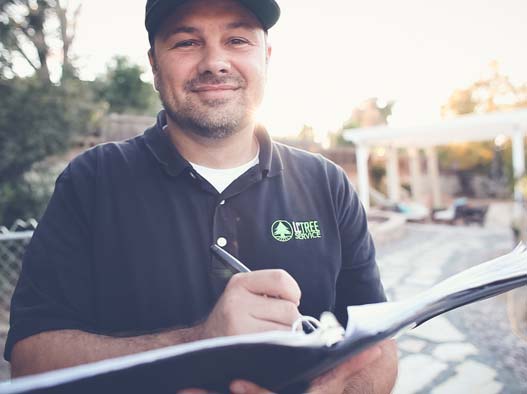 Going hand-in-hand with gauging a company’s professionalism, their customer service is still another factor to consider when you start contacting and meeting with different tree care companies.
Going hand-in-hand with gauging a company’s professionalism, their customer service is still another factor to consider when you start contacting and meeting with different tree care companies.
- Were your phone calls and/or emails responded to in a timely manner?
- Were they friendly on the phone or via email?
- Was the estimator friendly and make you feel like you would be taken care of?
- Did you feel like your desires concerning the project and opinion were heard?
After you decide to book your project with a company, the service you receive prior to booking can be reflective of the service you would receive during the job and afterward.
LET’S SUMMARIZE
CHOOSE A TREE SERVICE COMPANY THAT:

NEED ASSISTANCE WITH YOUR TREES OR PROPERTY?
LC TREE SERVICE WOULD BE HAPPY TO HELP!
619.677.5777
The post WHAT TO LOOK FOR IN HIRING A TREE TRIMMER first appeared on San Diego Tree Trimmers – LC Tree Service.
Best of Omaha 2022 – Omaha’s Best Tree Service
🌳 Meaningful growth for people and trees. 🌳
Did you miss our previous article…
https://www.treesforeducation.com/?p=239
HOW TO WATER YOUR TREES PROPERLY

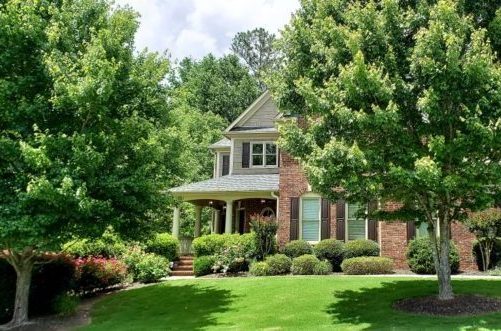
When it comes to watering your tree properly, it can be a bit tricky — as trees can suffer if you water too little or even if you water too much. So how can you tell if your tree is suffering from a lack or an excess of water? Unfortunately, signs of underwatering and overwatering your trees can be similar when it comes to the canopy and foliage, but do not stress because fortunately, there is a simple way to figure out which issue you have. The ground! Is it constantly damp or is it dry? Plain and simple.
UNDERWATERED TREE SYMPTOMS
- thinning canopy
- browning or yellowing of foliage (off-season fall colors)
- wilted or curling leaves
- untimely leaf drop
- dead branches
- small leaves
- slow growth
- pest infestation
Drought or underwatered trees are fairly easy to detect. For one, they don’t look healthy. The most obvious feature is that their canopy will be sparse, and their leaves will look an untimely fall color with wilting or curling. Then if you notice pests, it is definitely time to change your watering protocol and give your tree a nutrient boost through our Tree Health Care system.
When the tree’s drip zone (ground underneath the canopy) is devoid of water, the fine roots, which play an important role in water and nutrient absorption, begin to die back, thus affecting the health of the tree and displaying itself in the canopy and foliage. Eventually, if the tree continues to suffer from underwater stress, then the large, anchoring roots will dry up and die off as well. That’s when large trees become dangerous, as they become a likely candidate for tree failure.
OVERWATERED TREE SYMPTOMS
- frequent wet ground around the tree
- brittle leaves
- brown edges
- gray or black spotting on the leaves
- wilted or curling leaves
- yellowing or light green foliage
- untimely leaf drop
When a tree is receiving an excessive amount of water, the tree suffocates. Trees aide the planet with their ability to absorb carbon dioxide from the air and release fresh oxygen. But surprise, surprise — trees need oxygen too! The fine roots are also responsible for absorbing oxygen from tiny air pockets in the soil. If the tree is receiving too much water, water fills the air pockets, making it hard for the tree to breathe. The roots then produce methane, hydrogen, and nitrogen gases that choke out the roots, preventing them from performing their important duties for the tree.
HOW TO PROPERLY WATER YOUR TREE
HOW MUCH WATER FOR YOUR TREE
There’s a general rule of thumb for the amount of water to provide for your trees that may come as a shocker for most people — 10 gallons of water for every inch of trunk diameter! So if you do the math, a young tree with a skinny 2-inch trunk diameter that you just purchased from the nursery in a 5-gallon container needs 20 gallons of water according to that theory! Overkill? Possibly — although some arborists may argue otherwise. However, from our experience in the industry, as well as caring for our own personal trees, a newly-planted young tree does not need that hefty amount of water. So our verdict is…save your water!
As mentioned prior, you can learn how much water your tree needs by a simple screwdriver test. A majority of a tree’s roots sit in the top 12 inches of the ground, especially in urban settings where soil compaction and development can hinder deep root growth. When watering your tree, deep watering is the goal. And slow watering is the most efficient way to reach that goal. So provide enough water for your tree until your screwdriver, if you’re doing a screwdriver test, can easily be pushed all the way down. Then water a bit more, and then your tree will be a happy tree.
RECOMMENDED METHODS TO WATER YOUR TREE
Hose. Since trees require so much water, standing there with your hose will be extremely time-consuming. In addition, watering with the hose on high pressure will shower the tree with more water than the soil can absorb, which will result in wasted water run-off. A more efficient method in using a hose is to turn it on as low as possible so water is slowly dribbling out. After 20-30 minutes, move it to a new location under the canopy. Keep repeating until the tree’s drip zone has been sufficiently watered. Depending on the size of the tree, this may take 1-2 hours — so make sure to set your timer.
Soaker Hose. An easier and efficient method is using a soaker hose that is placed under the tree’s canopy. Soaker hoses are porous and allow water to slowly seep out. This gradual release of water minimizes wasted water and maximizes water absorption. The soaker hose should be placed in a circular pattern under the canopy of the tree and turned on for an hour or more. The goal is for the water to penetrate eight inches into the ground, which can easily be determined using the screwdriver test. Push an 8-inch screwdriver into the ground. If it pushes easily all the way, the ground is moist. Easy does it!
Dripline. The easiest method to watering your tree is using a drip irrigation system. However, it is also one of the most difficult to install. But once installation is complete, the rest is a no-brainer. Just like with a soaker hose, the dripline should be set in a circle under the canopy and run for an hour or more, contingent on factors such as the tree’s size, species, and climate.
Sprinkler. Sprinklers are another common system for watering landscape. Like the drip system, installation can be time-consuming and difficult, but once completed, the work is automatically performed for you and can be adjusted according to the tree and the season. Sprinklers are great for watering lawns and any area of land that is mostly covered with landscaping, however when they are used to water trees that are not heavily surrounded by other plants, then weeds will become an issue.
Bucket. If you need an easy method to water your tree that doesn’t require much time and doesn’t require the purchase of any additional “fancy” tools, you can always use the good ol’ 5-gallon bucket that is hanging out in your garage. Drill holes on the bottom portion of the bucket and place it in the tree’s drip zone. Fill the bucket with water and let it empty out. Then move the bucket to a new location, and repeat the previous step until the tree has received a sufficient amount of water.
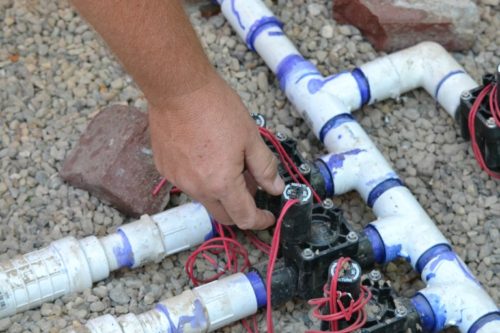

HOW OFTEN DOES YOUR TREE NEED TO BE WATERED?
Newly planted trees will require more water during the first 1-2 years. Their root structure is limited to a smaller area, and it needs to expand in order for the tree to thrive. However, when a tree is freshly transplanted, it undergoes a period of shock — which is why you may see leaf drop or signs of deterioration. Have no fear though. With proper care and patience, your tree will bounce back.
During the first two weeks after being planted, new trees need to be watered at least three times a week over the root ball, or even daily in dry, hot weather. Then, for the next ten weeks, this can be reduced to 1-3 times a week. For the rest of that first year up until the fifth year, the tree will need to be watered twice a month, or even weekly during times of heat or drought. For the first two years, water needs to be concentrated over the root ball. After that, the watering zone can be expanded to accommodate the growing root system.
YEAR ONE
Weeks 1+2
Weeks 3 -12
Rest of 1st Year
Water 3-7 times a week over the root ball.
Water 1-3 times a week depending on the weather over the root ball.
Water 2 times a month over the root ball.
YEAR TWO
Hotter Months
Colder Months
Water weekly or bi-weekly over the root ball.
Provide supplemental water when necessary.
YEAR THREE
Hotter Months
Colder Months
Water weekly or bi-weely to an area twice the width of the root ball.
Provide supplemental water when necessary.
Once a tree is established and mature, they will have such extensive roots that they are able to tap into deeper groundwater or may even creep into your neighbor’s property to take advantage of their water system. However, if it has not rained in at least a month, then supplemental water will still need to be provided. Remember that a water-deprived tree is weaker and susceptible to pests and disease, so keeping it as healthy as possible is key to its longevity.
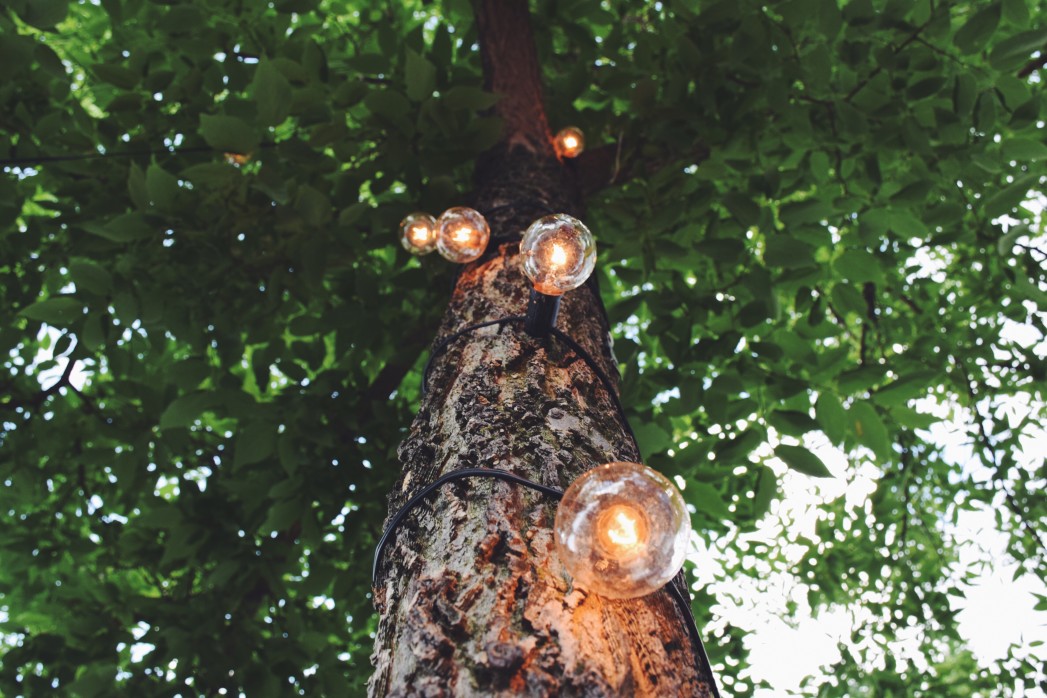
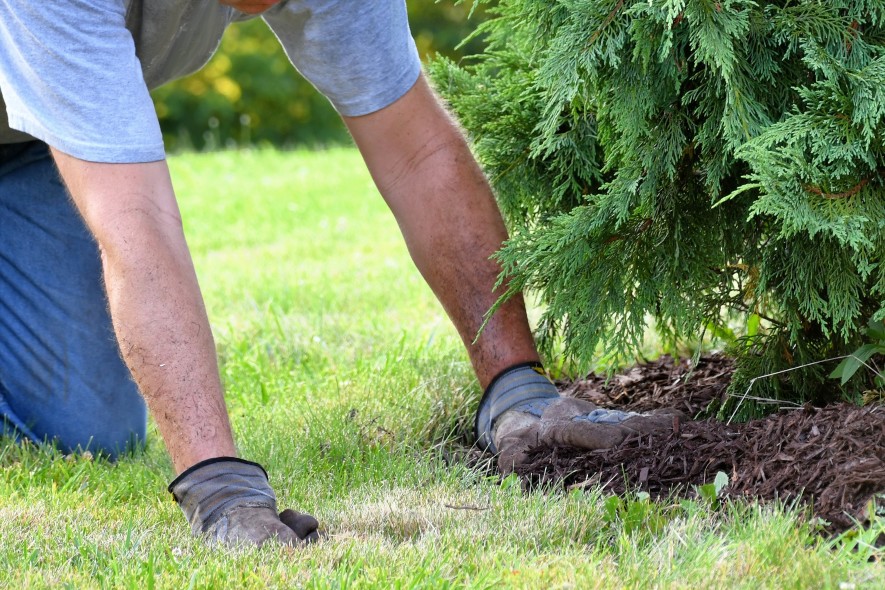
OTHER MEASURES TO HELP YOUR TREE
MULCH
Adding mulch as groundcover for your trees has many benefits that should not be overlooked. For starters, adding mulch helps prevent soil compaction by buffering the impact of water that can result from watering with a hose or from hard rain. Remember, trees get oxygen from tiny air pockets in the soil, so its important to keep the soil from getting too compacted. Mulch also acts like a layer of protection by helping to stabilize the ground temperature during extreme weather. During the hotter summer months, the ground will be slightly cooler, which results in less water evaporation and more comfortable roots. Happy roots, happy tree.
When applying mulch, it is important not to be too excessive. Trees only need 2-3 inches of mulch. Anything more will be asking for an array of problems, such as suffocation of the tree’s roots, wasted water, and a higher susceptibility to rodent pests and diseases. Therefore, avoid creating a mulch volcano. As the name implies, do not place down so much mulch that it ends up looking like a volcano around your tree.
CAMBISTAT
Cambistat is a plant health care additive developed by Rainbow Treecare Scientific Advancements that is quickly growing in popularity in the landscape and arboricultural industries. Cambistat was created primarily as a growth regulator, but it has several side results that are so beneficial for trees that people across the nation are raving about this product. Since the tree shifts its focus from above-ground growth, its energy is applied more towards underground growth with the roots, more specifically fine roots, which are primarily responsible for water, nutrient, and oxygen absorption. The end result is an overall healthier tree with greener foliage, increased resistance to disease, and increased resistance to heat and drought.
Even though Cambistat is a growth regulator, any size tree, big or small, would benefit from it. Many people use Cambistat to help control the size of their mature trees, but why would anyone use it on a young tree? Aren’t people anxious for a teeny, weeny, baby tree to grow to a large, lush adult tree? Yes, but remember that new transplants don’t grow much anyways the first two years after being planted so they could focus on root growth. Therefore, adding Cambistat during this period would be great timing so it could expedite the root growth process.
The effects of Cambistat can last for up to three years. After that time, you can choose to have it reapplied or skip reapplications so that a young tree can now refocus on trunk and limb growth. Either way, the tree will now have a stronger root system that is well set up for water absorption.
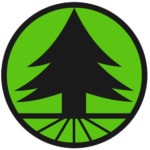
LOOKING FOR A TREE SERVICE COMPANY?
CONTACT LC TREE SERVICE TODAY FOR YOUR FREE ESTIMATE.

The post HOW TO WATER YOUR TREES PROPERLY first appeared on San Diego Tree Trimmers – LC Tree Service.
HELPING TREES IN THE SUMMER HEAT

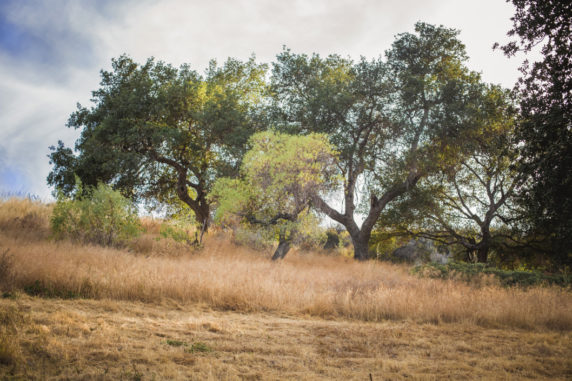
When the summer arrives in San Diego, some trees and plants may fare well, but others, unfortunately, succumb to the summer heat. While coastal San Diego communities have little to worry about with heat-related tree “fatalities,” inland neighborhoods such as El Cajon and Santee, typically have about four months of high temperatures in the 80’s, 90’s, and 100’s. Many people can shelter indoors to enjoy the cool AC or take a dip in the pool or beach — but what about the trees?
Trees and plants suffer in high temperatures for two short and simple main reasons:
- lack of water
- small root system
Which trees are most vulnerable in the summer?
NEW TRANSPLANTS. Trees that have just been planted into the ground have a smaller root system that is limited to the size of the container they came in. When you first plant a tree, you may notice…well nothing. No growth. Nothing during the first year. And nothing much in the second year. Nada! That is because the growing action is occurring underground with the roots. In order for the new tree to survive and thrive, its roots will need expand well beyond its current space. Roots are opportunistic and will grow where the nutrients and water are available. Please see the following section on how to properly water new trees.
POTTED TREES. The roots of these trees have the unfortunate disadvantage of not being able to travel past its borders. They’re stuck! So potted trees need extra love and care in the summer heat. Depending on the species, some trees need to be watered daily — sometimes even twice a day when the heat gets extreme. A general rule of thumb is to water when the first inch of soil is dry in the pot.
SICK OR INFESTED TREES. When a tree is inflicted with disease or pests, then high temperatures will just be added stress to an already struggling organism. Therefore, it’s important to make attempts to manage any tree infestation or infection before the summer heat arrives. If you suspect that your tree may be suffering from disease or pests, please contact LC Tree Service for information on our Tree Health Care treatments, so we can help you get your trees healthy again.
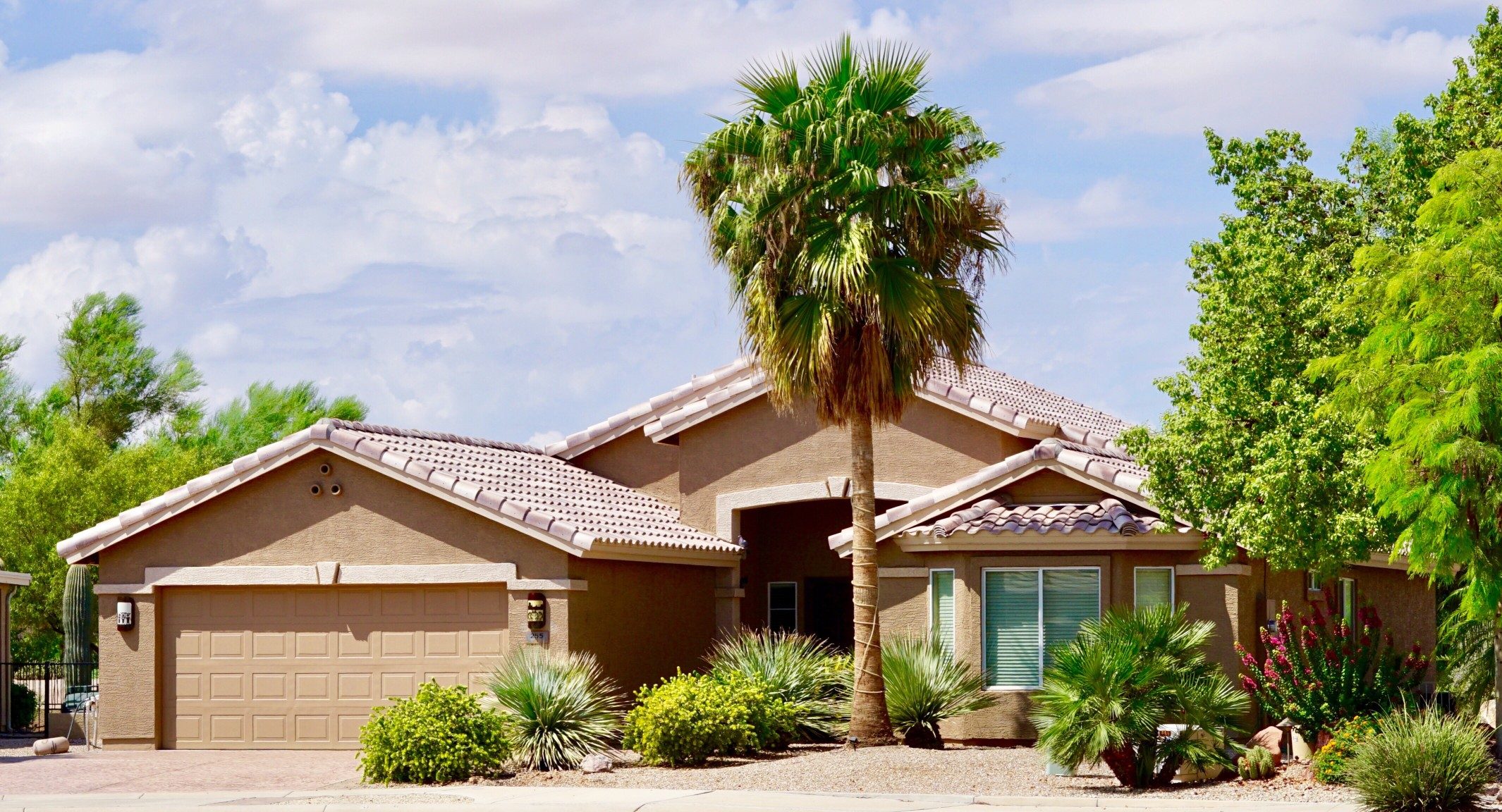
How can you help your trees in the heat?
PLANTING SEASON. First of all, if you are planting new trees onto your property, avoid doing so in the summer. The fall and the spring are the best times of the year to add any new additions to your landscape since they have less extreme temperatures. The ground also tends to be moister in the spring, thus aiding in root expansion. Remember, that roots will go where the nutrients and water supply are, so if a large expansion of the ground around the tree is damp, the roots will have an easier time growing outward.
WATER APPROPRIATELY. Make sure to provide plenty of water for your trees in high temperatures, especially new trees. You need to make sure that the roots do not dry out. The best time to water is in the morning to give the roots more time to soak up the water. As for the amount of water, there is a popular general rule-of-thumb among arborists of providing one gallon for every inch in trunk diameter in the tree’s drip zone. If you do the math, a 2-inch diameter tree will need 20 gallons of water. Yes, that’s a lot of water! At medium pressure, a hose will spray out roughly 10 gallons of water every five minutes. Therefore, to adequately water this tree, it would take 10 minutes! However, we have seen trees thrive without this amount of watering, and we recommend that you gauge how your tree is doing. If your tree appears to be suffering, then water more. But if it is green and healthy, then maintain your current watering amount and schedule. To keep it simple without having to do any trunk measurements and calculations — water deep. This is why slower is better. Rather than watering with a hose, we recommend setting up a drip line or soaker hose under the tree’s drip zone, which is the area under the tree’s canopy. This efficiently maximizes the amount of water that is soaked into the ground and made available for the roots. An excessive shower of water from a hose could just result in wasted runoff. Plus, who wants to hold a hose for an hour to water all of their trees?
Newly-planted trees should be watered daily for the first two weeks after being planted. Then 1-2 times a week for the next 10 weeks. It can take 2-3 growing seasons for a tree’s roots to expand outside of its “comfort zone,” so until then keep the water in fairly close proximity to the tree since the roots are clustered around its root ball. Mature trees only need to be watered twice a month, possibly more during extreme heat.
MULCH. Spreading mulch around trees can be very beneficial, especially for young trees. When a tree is well-mulched, the soil around the tree is slightly cooler in the summer. And since direct sunlight on the soil is prevented with a mulch cover, water retention is improved. When applying, overmulching is possible. A tree only needs about 2-3 inches of mulch. Anything more would absorb too much of the water that is meant for the tree and it could also choke the tree’s roots. However, a proper amount of mulch has many benefits including improving root growth, moderating soil temperature in the heat (as well as in the cold), increasing nutrient levels, and preventing soil compaction.
CAMBISTAT. Arborists nationwide have a brilliant trick up their sleeves. Its name — Cambistat. Primarily used as a growth regulator for mature trees and other plants, Cambistat can reduce tree growth by up to 70% over a 3-year timespan. It works by inhibiting the tree’s growth hormone called gibberellin. By doing so, the tree is able to focus its energy on other aspects, such as fine root growth, which aide the tree in water and nutrient absorption. Other effects include greener foliage, increased disease resistance, and greater heat and drought tolerance. While it seems counterintuitive to use a growth regulator on a young tree, as mentioned before, new transplants don’t grow much above ground anyways in the first couple of years so they can focus on root growth. So having Cambistat applied would only supercharge the much-needed root expansion.
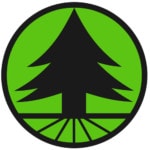
NEED HELP WITH YOUR TREES?
CONTACT LC TREE SERVICE TODAY FOR YOUR FREE ESTIMATE.
The post HELPING TREES IN THE SUMMER HEAT first appeared on San Diego Tree Trimmers – LC Tree Service.
SOARING HEIGHTS WITH TREE TRIMMERS
Ever wonder what it feels like to be a professional tree trimmer? To be up a 100-ft palm swaying with the wind? Yikes! Or to sit atop a tree overlooking the neighborhood? To the adrenaline junkie or someone who abhors the thought of sitting at a desk for eight hours a day, being a tree trimmer is an ideal career. They get to hone in on their inner tree-climbing child for a living, but this time with menacing chainsaws and large trucks and equipment! It may a tiresome and dangerous career, but it sure is exciting!
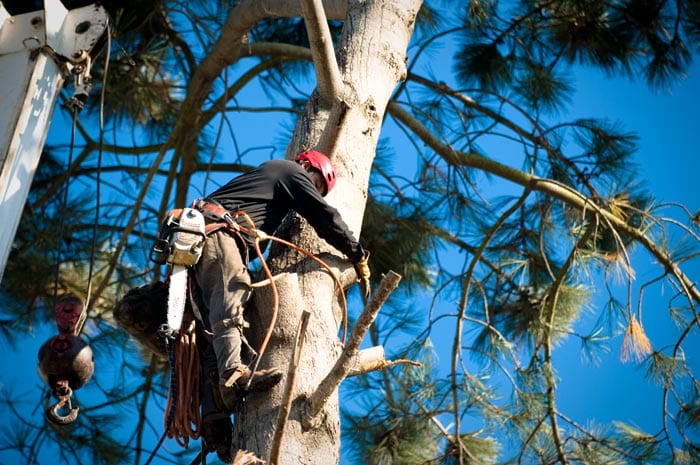
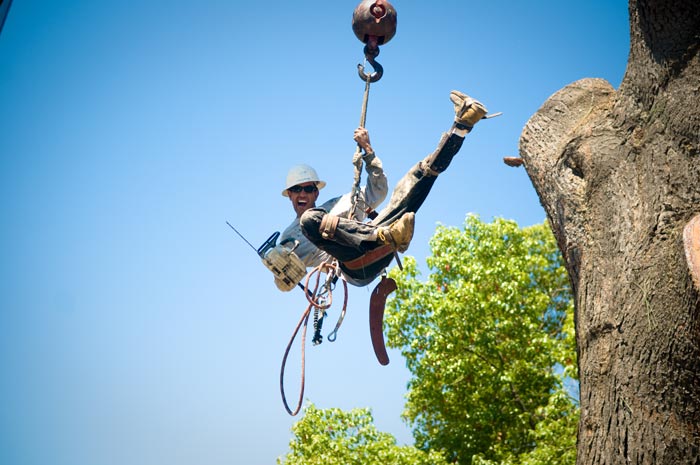
Do tree trimmers have a fear of heights?
When asked about a fear of heights, CEO, Larry Coalson, describes himself not NOT having a fear of heights, but rather a HEALTHY fear. Sitting 40 feet up in a tree doesn’t bother him the way it would your typical person. Even sitting at the edge of a cliff with a 200-ft drop doesn’t paralyze him with fear—unlike other people who get dizzy just thinking about it. Larry, on the other hand, views sitting on the edge of a cliff like sitting on a 10-ft wall. If you sit properly, your chances of falling are unlikely. BUT if you’re acting foolish, dancing along the edge, or just being plain dumb, then yes, you just might fall off!
Tree trimmers trust to some degree the trees that they climb onto. It doesn’t mean, however, that they trust all trees. Some trees can be too hazardous to climb, such as ones that are dead or rotting. Other trees could be too skinny and frail to give even a 50-lb child any sense of security, let alone a 180-lb man with a heavy chainsaw. This is why proper training and experience play a crucial role in keeping a tree trimmer safe, as well as the entire field crew and the property that the job is being performed at.
In San Diego, a couple of local trees that can make a grown man sweat with uncertainty are the lemon-scented eucalyptus and any tall Mexican fan palm whose crown is beyond the reach of a boom lift, so it therefore has to be climbed all the way to the top. Both of these trees (although technically, the fan palm isn’t a tree) grow tall and lanky—even known to soar past 100 feet in height. And not only are they tall, but they’re skinny and flexible. Bad combination for a tree trimmer, who couldn’t care less about swaying back and forth 60 feet up in the air on a tree trunk with a diameter of less than a foot. His only hope is that he’s not too heavy to cause it to snap.
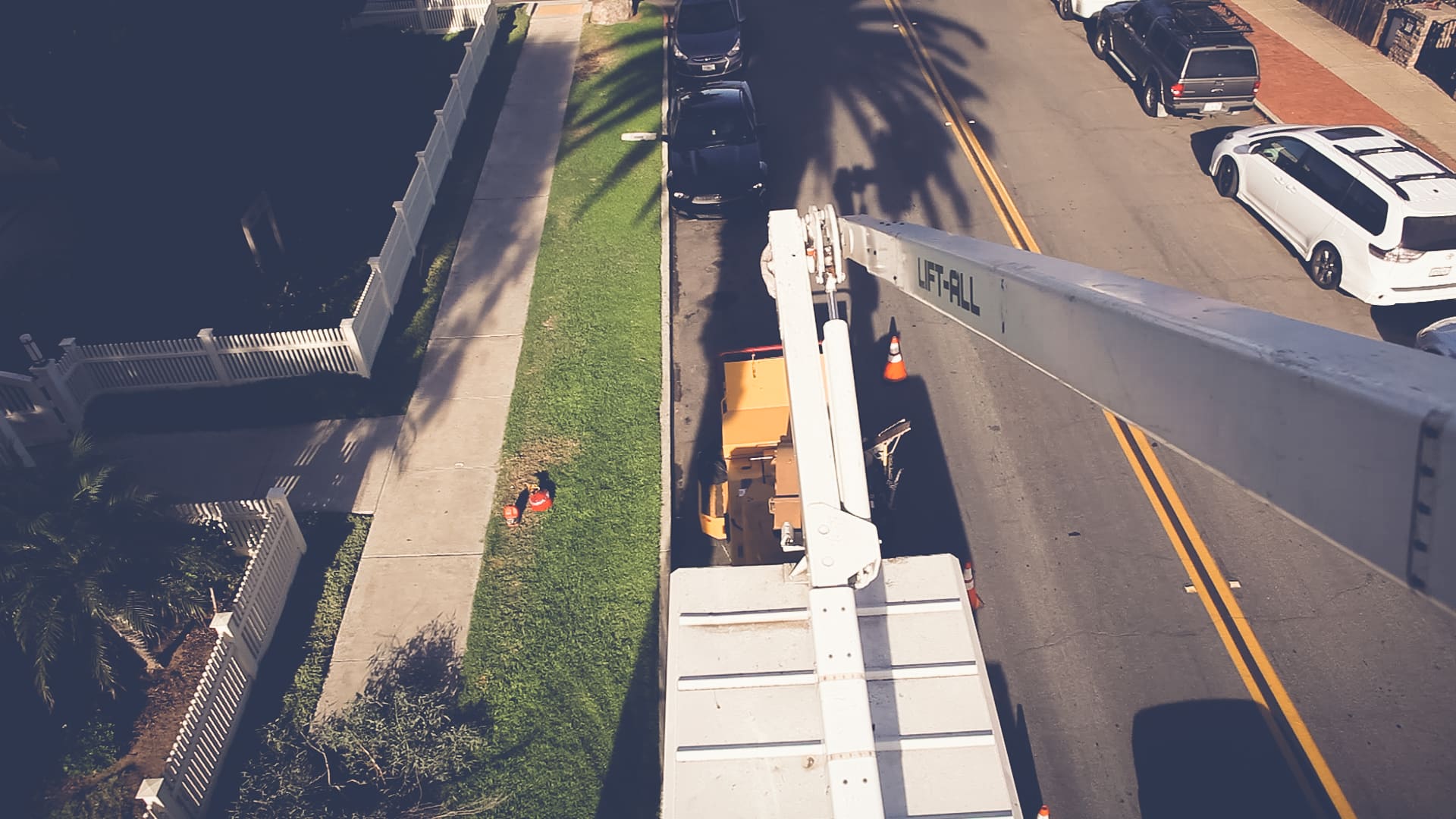
It’s a dangerous job—but someone has to do it!
Almost every tree trimmer goes through some degree of fear on the job—whether it be a minor uneasiness or a serious “I’m about to die!” terror. Practically every aspect of the job can be dangerous on a daily basis. Falling tree parts. Even worse…unexpected falling trees. Hazardous working heights. Dangerous chainsaws. Deadly chippers. Stabbing spikes that go right through the sole of a boot. Stinging bee armies. Electrical lines. And that’s just the tip of the iceberg.
According to the Bureau of Labor Statistics, the tree industry tops the nation’s list of the most dangerous jobs, with falling tree parts and equipment operation injuries being the main culprits for injuries and fatalities. It’s a dangerous job, but someone has to do it! But why would anyone want to put themselves at such risk on a daily basis? While Larry Coalson may not climb trees much anymore, back when he did climb for a living, he loved the daily adrenaline rush. The thought of sitting at a desk all day long made him cringe, but the thought of scaling up a tree for a living gave him a deep sense of excitement. The smell of the outdoors. The array of lurking dangers. The dangling heights that most people never get to experience. It all added to the love of his job—as dangerous as it was.
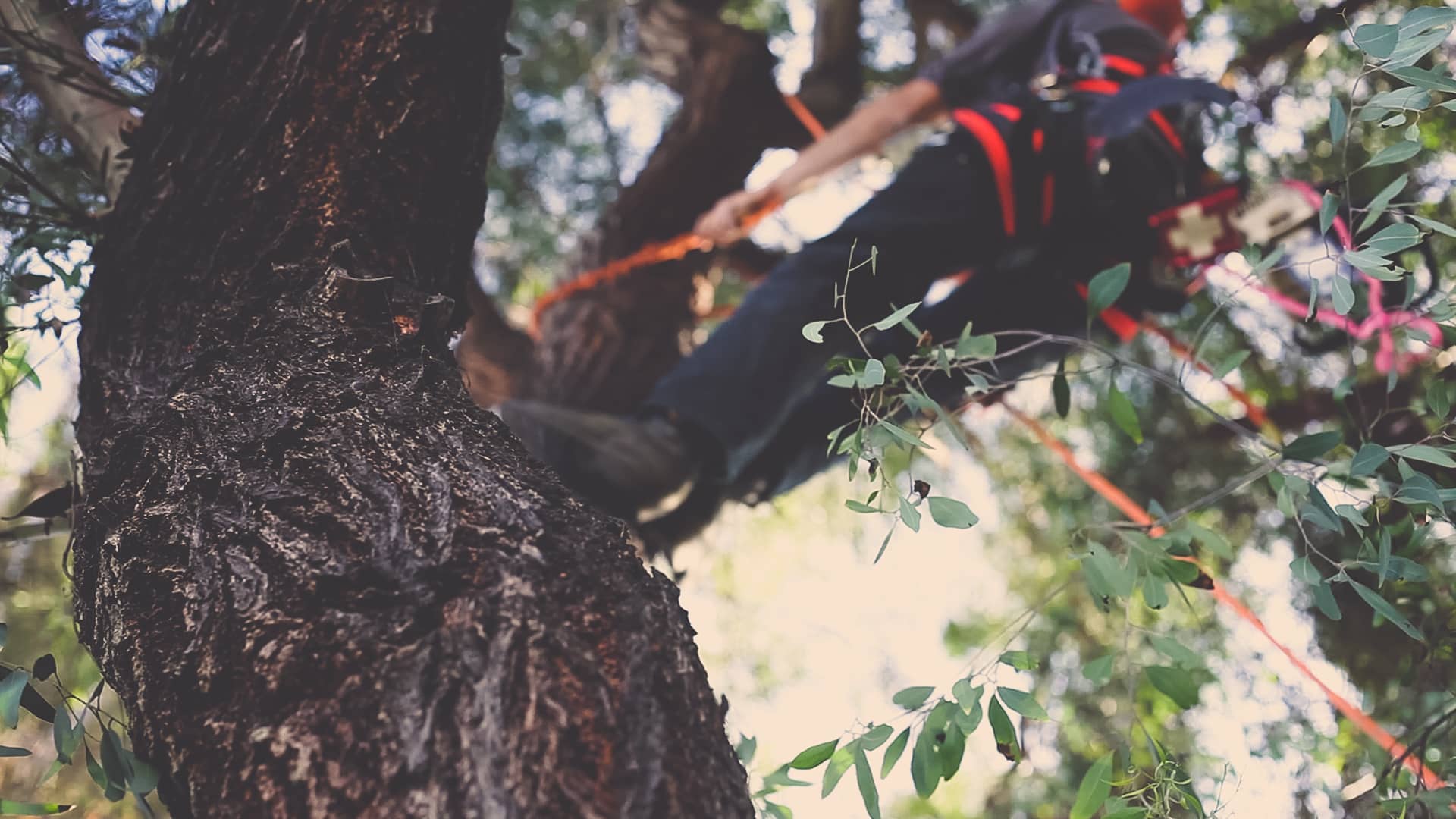
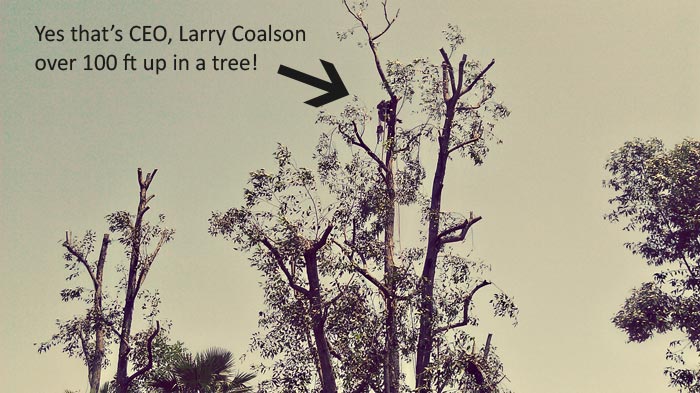
The post SOARING HEIGHTS WITH TREE TRIMMERS first appeared on San Diego Tree Trimmers – LC Tree Service.
IS YOUR TREE INFECTED OR INFESTED?
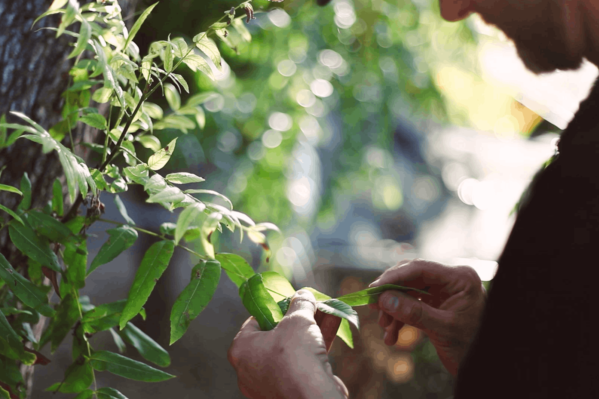
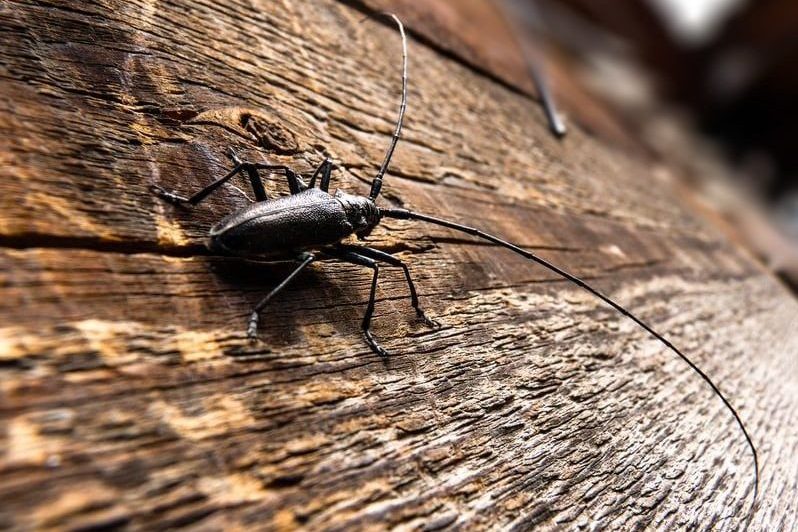
Trees can be a prized addition to any property, especially when they are large, mature, and well-maintained. Most people plant young, smaller trees on their property to save money and simply wait for the tree to grow to an ideal size, since transplanting a mature tree has a hefty price tag! Depending on the size of the tree, it can cost several $100,000. Yikes!
So when your cherished investment that you’ve been watching grow for the past 10 or 20 years starts to show signs of an infection or pest infestation, what should you do? IS there anything you can do to save your tree from further decline? The answer can be “yes” or “no.” The key is early detection. If an invading virus, bacteria, fungus, or pest has penetrated too deeply into the tree’s system, the extensive damage has been done and the only recommendation would be a tree removal. However, if the invaders are caught “red-handed” early on, then controlling, even eradicating them, is much more simple. Thankfully, there are several evident signs that you can look out for.
INFECTION + INFESTATION SIGNS
UNSEASONAL YELLOW OR BROWN FOLIAGE
When a tree is struggling with sickness or infestation, one of first signs that a property owner will notice is the change in the tree’s leaves. Nutrients are being robbed or nutrient absorption is hindered by the damage that is inflicted by the invaders. As a result, the tree’s foliage starts to die back and lose its color. This can be a tricky indicator source for an untrained eye, however, during the fall and winter months, since that is the time of the year when the leaves from deciduous trees naturally die off. Occasionally, we’ve received an inquiry from someone wanting their “dying” tree removed for safety concerns—when really it was winter, and the tree was simply doing what trees do in the winter. When deciduous trees start to go into hibernation, the discoloration in their foliage tends to spread throughout the entire canopy fairly quickly compared to that of an infested or infected tree. You should also note that evergreen trees shouldn’t have patches of browning foliage, as they are meant to stay green all year round. Therefore, using this indicator for evergreens, like pine trees, is more clear-cut than it would be for deciduous trees.

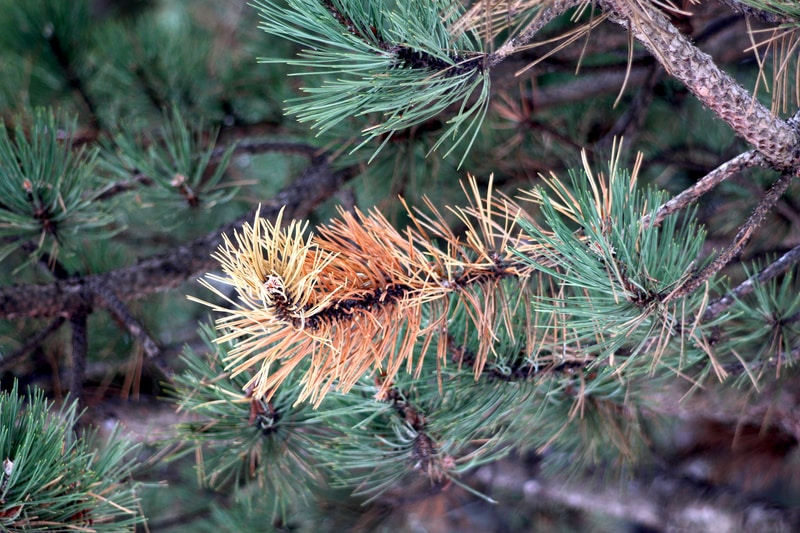
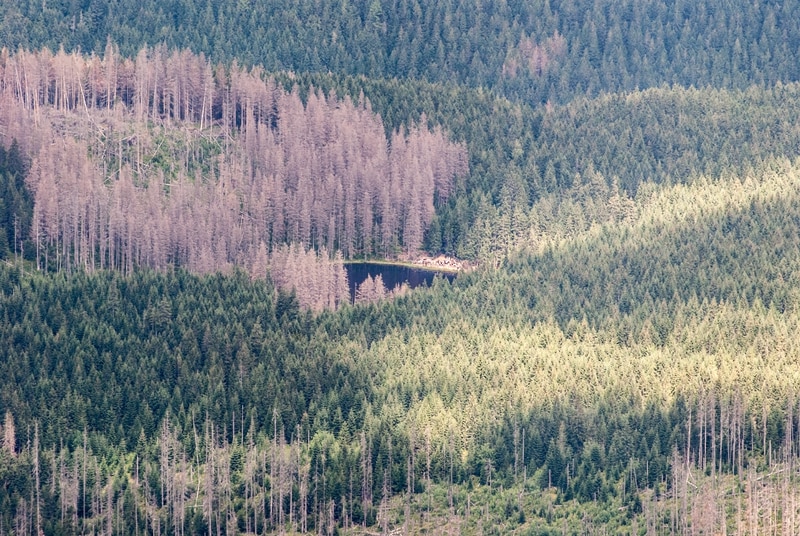
LEAKING TREE
Leakage from a tree is indicative of an injury, which could be a non-issue or a big issue. Anytime a tree loses a limb from a trimming or natural causes, it sustains an injury, which can cause it to bleed or leak sap. Typically, a tree will seal up its injuries—the same way our bodies heal up cuts. However, unlike the human body, trees do not heal—they seal. They do not repair the injury from the inside out, but instead compartmentalize the wound and form new callus tissue around and over the injury.
WETWOOD, or slime flux is a very common bacterial infection found in many trees. Oftentimes it can be found at the crotch of tree due to cracks in the wood or at a pruning site. But sometimes it be found just about anywhere on a tree. The bacteria makes its way into the heartwood and sapwood, typically through root injury. It, then, does its little thing, causing gas buildup. This increase in pressure pushes the sap out through any little crack or weak spot on the tree’s outer layers. Unfortunately, there are no known treatments for slime flux. But thankfully, it’s an infection that isn’t a big deal. Occasionally, it can have detrimental effects on an unhealthy tree—but for the majority of affected trees, it’s harmless.
BORING BEETLES are to blame for many sap leaks found in trees, especially in San Diego’s oaks and pines. Any tree that already has leaking sap is an easy target for these invaders, because it signals an easy entrance in, and it could also indicate that the tree has a weaker defense system. If beetles don’t enter through an already-existing wound, then they’ll eat their way through the bark to make a new home for their upcoming brood of cute little larva babies. Once the larvae are fully mature, they bore their way all the way out of the tree, leaving behind exit wounds or D-shaped holes. If the infestation is new, then the exist wounds may leak sap, which is still a good sign that the tree is still vivacious enough to try to defend itself. However, if a tree contains a number of dry holes that aren’t leaking, then it’s an unfortunate sign that the tree has been under attack for quite some time. The key to avoiding a beetle infestation from killing your tree is early detection. Spot a few holes, your tree may be okay. Spot more than a dozen, then contact LC Tree Service immediately for a consultation and possible treatment plan.
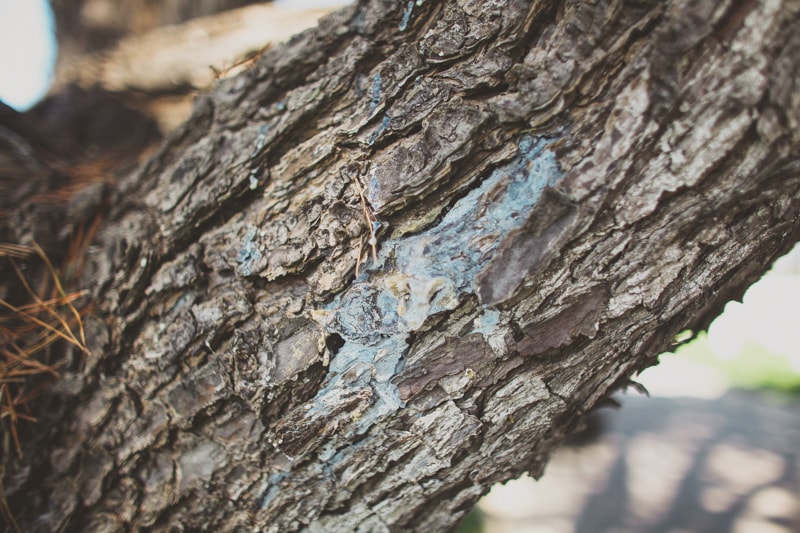
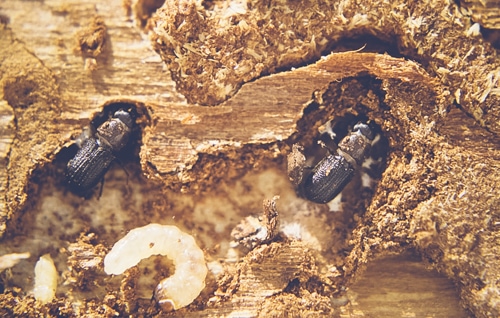
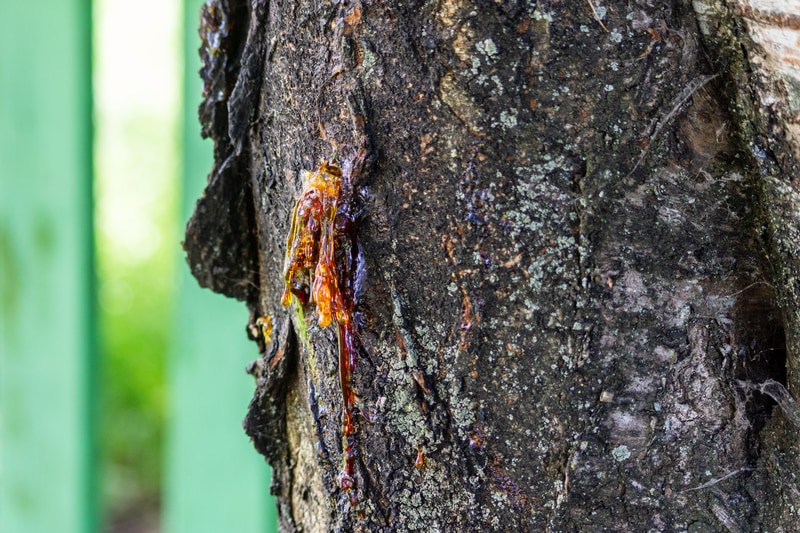
CONKS OR MUSHROOMS
Mushrooms on a plate of spaghetti—a great addition! Mushrooms at the base of a tree trunk—BAD!
Mushrooms, or conks, are the fruiting body of a fungus. While not all mushrooms are equally damaging to a tree, most are an external sign that something detrimental has already been going on internally or underground within the tree’s roots. Some fungi go directly for the roots, while others enter the tree through exterior wounds on the trunk or limbs that are caused by any number of sources, including tree trimming, cracks in the bark, blades from a lawnmower, or any other means of damage. Then the real impairment begins as the fungus releases an enzyme that breaks down the tree’s tissue to begin eating away at a seemingly unending source of food.
If the tree’s roots and/or base have been under fungal attack, then it makes the tree a likely candidate for breaking and falling—or what is known as tree failure. While fungicide treatments can slow down the spread of the fungus, in most cases where mushrooms are present (especially at the base), the tree is beyond repair due to the extensive internal damage that has already been done. If the foundation of the tree has been compromised, then unfortunately, the safest measure would be a tree removal.

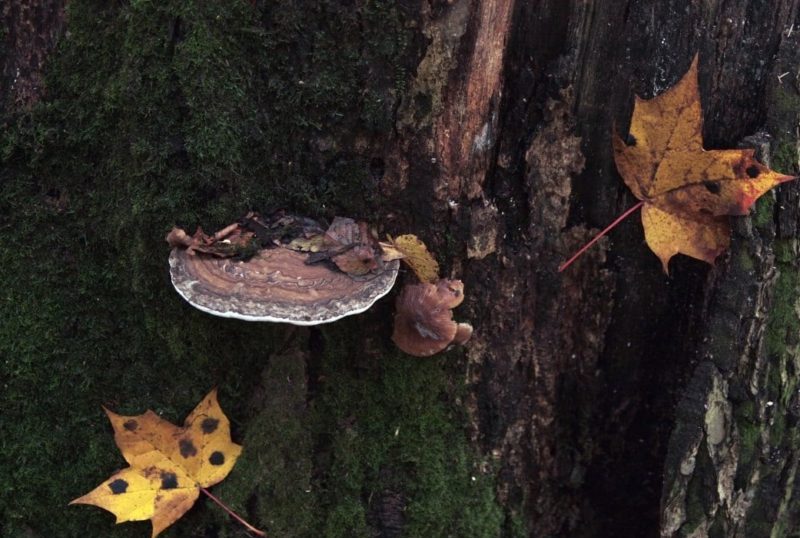
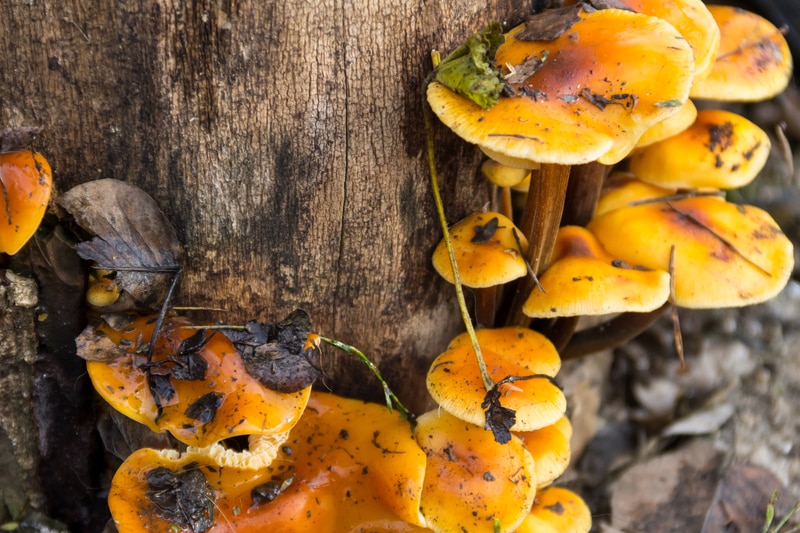
POWDERY MILDEW
If you notice a white powdery substance on your tree’s leaves, have no fear—it is a common fungal disease that is easy to remedy. The powder is the result of airborne fungal spores that spread with the wind to look for new trees to inflict. When a tree has been infected, white to grey fuzzy blotches appear not only on the leaves, but also on the stems and buds. This is a tree infection that is unavoidable in many parts of the world and can strike almost any tree. However, the most preferred tree species include oaks, dogwood, magnolia, maple, azaleas, lilacs, and crape myrtle.
The fungus thrives in humidity and in temperatures above 60 degrees—although it can still be found in arid climates as well. In the winter, it lies dormant, and it is awakened by the warmer spring temperatures. Growing season! New spores are produced in the dampness of the night, which are then carried off during the day by the wind. This process continues as long as the humidity levels and temperatures are high enough.
While the fungi that cause powdery mildew are hard to avoid, there are steps that you can take to prevent your trees from being infected.
- Plant trees in areas with plenty of sunshine to aide in keeping its foliage dry.
- Avoid wetting the foliage in the late afternoon.
- Keep trees well-trimmed to help increase air circulation and light penetration.
- Plant trees with plenty of space in between trees to help avoid cross-infection.
- If planting a new tree, consider a less-susceptible tree species.
Fortunately, this fungus is one that can be controlled with proper fungicide. Please contact us, if you notice leaf powder on your trees to avoid spread and leaf distortion.
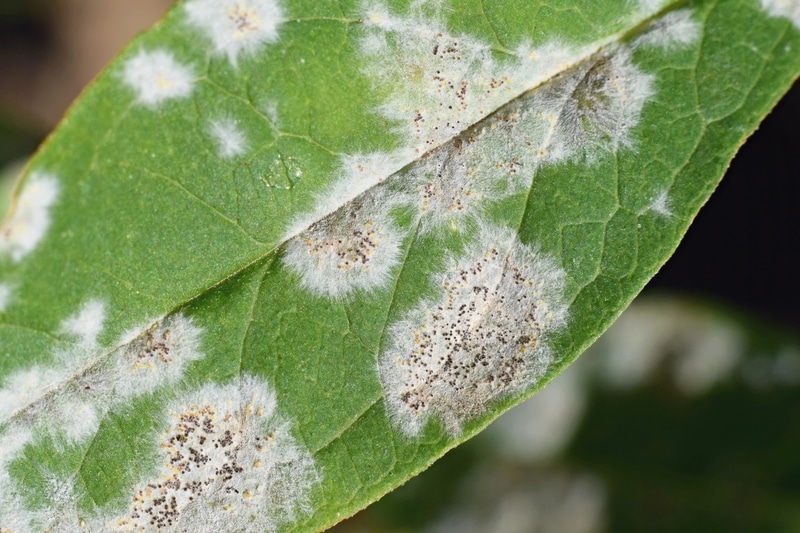
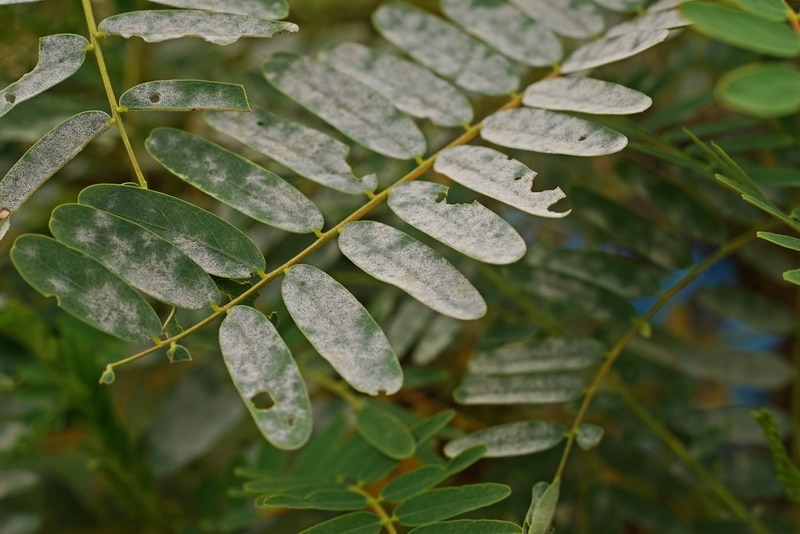

LOOSE BARK
All trees shed off their bark and crack to some degree. It’s simply their natural process of growing out of their skin. It could even just be the tree suffering from extreme elements, such as frost or extreme heat—in which some tender love and care to bring them back to a healthy state.
Some trees shed more than others, like the melaleuca tree that is so common to see in San Diego. This is a local tree that is ALWAYS shedding off its bark in a unique fashion that looks like paper peeling off, hence giving it its nickname—the paperbark tree. The various eucalyptus trees around the city are also notorious for molting. However, if a hardwood tree such as a pine has loose bark that comes off with a slight tug, then there is an underlying issue that should be inspected by a tree professional.
To better decipher whether your tree is going through its normal exfoliation process, look to see if there is a layer of fresh bark behind the shedding layer. If so, then that is a good sign that your is simply shedding. But if you see bare wood that has a fuzzy fungus or lighter-colered wiggly lines, then you have an issue. Your tree is suffering from either a fungal infection or a beetle infestation.
DISEASE. A common culprit for peeling bark on trees is a fungal disease called Hypoxylon canker. Its most popular victim is the oak tree, although different
Hypoxylon species will affect different host trees of choice. Being a fungus, it spreads through aerial spores, but will only cause harm to weak and stressed trees that are easy prey. Healthy trees typically have no issue defending themselves against Hypoxylon. In fact, many healthy trees already have the fungus on their outer bark, but they won’t be affected unless their natural defense mechanisms are compromised by factors such as malnutrition, drought, heat, insect attacks, etc.
Unfortunately, there is no known cure for Hypoxylon canker. Because the fungus lives in the interior of a tree, once the infection become evident from the outside, the irreversible damage has already been done. The typical protocol would be a removal of infected limbs or removal of the entire tree, especially if the fungus has affected the trunk.
BEETLE INFESTATIONS are a common cause for loose bark, especially with the pines in San Diego. The beetles feed mainly on the tree’s sapwood located just beneath the bark. This eventually causes the bark to loosen up and fall. Boring holes in the trunk are a tell-tale sign that the tree is infected with beetles, but for curiosity’s sake, if you wish to see their burrows, you can try peeling off a section of the bark—which will uncover a chaotic mess of the beetles’ burrowing lines. Take note though that if you are able to peel off the bark that easily, then the tree is beyond saving.
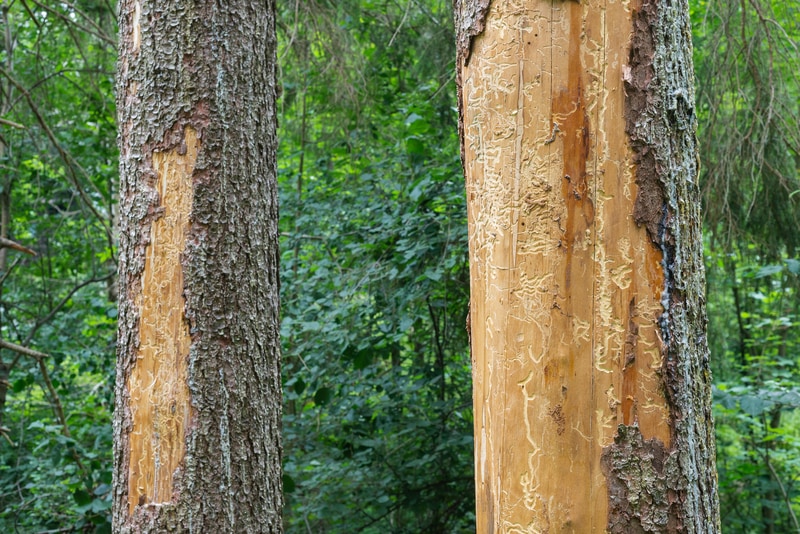
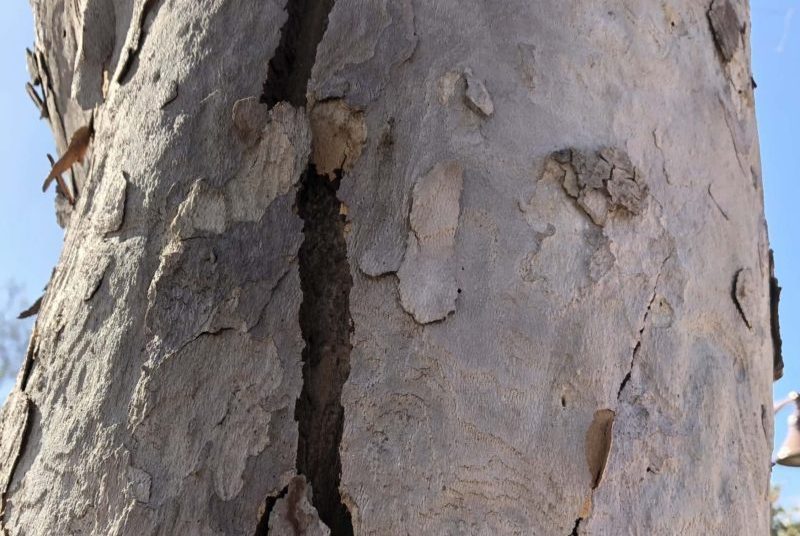
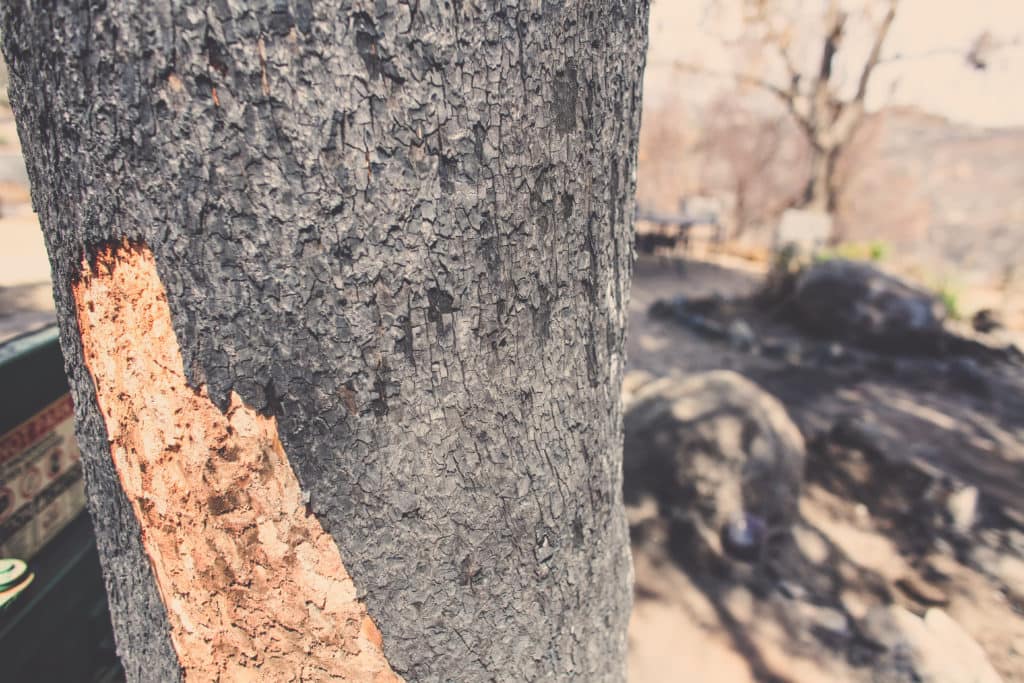
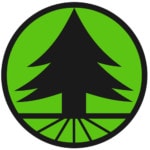
IF YOU HAVE AN INFESTED OR INFECTED TREE,
PLEASE CONTACT LC TREE SERVICE IMMEDIATELY
SERVING ALL OF SAN DIEGO COUNTY
The post IS YOUR TREE INFECTED OR INFESTED? first appeared on San Diego Tree Trimmers – LC Tree Service.
EMERGENCY TREE REMOVAL IN SAN DIEGO
Rain and wind in San Diego! It’s that time of the year when the residents of San Diego either get excited about finally getting a change in the weather or they find it distressing that their “perfect” sunny weather is getting disrupted. San Diego’s storm season typically occurs during the cooler months of December through March. While our storms are mild and cannot compare to the blizzards, tornadoes, hurricanes, and tumultuous lightning storms that take place throughout much of the country, our winter weather is still capable of causing its share of damage.
Unfortunately when the rain and winds push through San Diego, it is common to see trees topple on top of homes and other structures and our city roads. It doesn’t even take much for trees to start falling around our county. Depending on the tree and its circumstances, sometimes a slight gust will give it just the right push to expose its weakness. While some arborists disagree over whether some species are more prone to failure than others, the fact is that any tree has the potential to fall without any prior indication — even seemingly healthy trees.
The leading reason for tree failure lies in the combination of the tree’s weight and root structure. The denser the canopy of the tree and/or the larger and heavier the trunk, then the more weight the roots are required to support. The roots play a vital role in anchoring a tree, and when they are compromised by variables such as urban development, fungus, disease, and age, then a massive 70-ft tree per se will end up being more sensitive to the power of the wind.
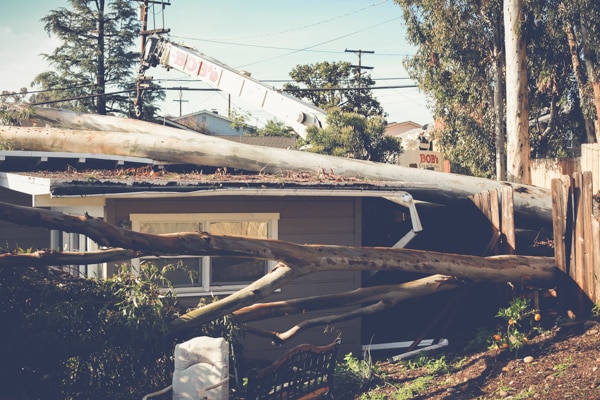
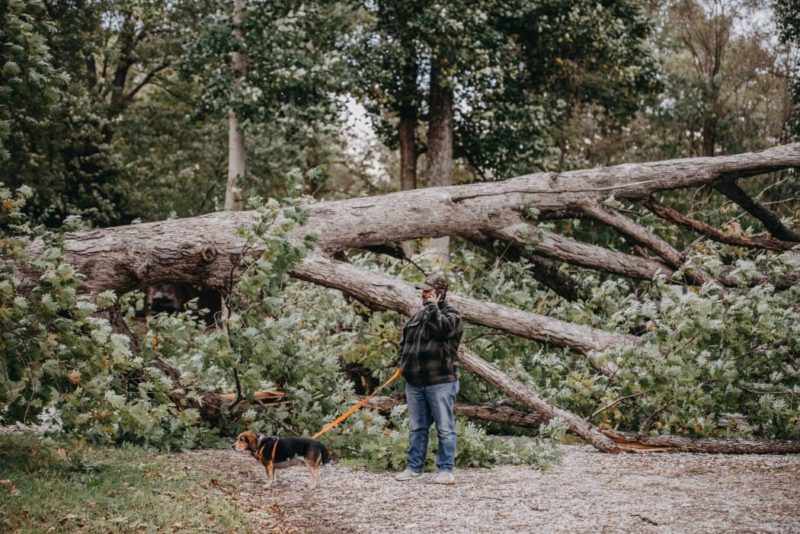
WHAT TO DO IN A TREE FAILURE EMERGENCY?
If you are an unfortunate property owner with an unexpected fallen tree, the first step you should make is to ensure that everyone in the house or building is safe and take immediate medical action if any injuries were incurred. If the breakage poses any harm, such as broken glass or broken electrical wiring, then everyone should keep their distance or evacuate until the damage is inspected by trained professionals.
Once necessary medical attention is taken, then the next step is to either contact your insurance company or LC Tree Service to have a professional come assess the situation. We are available for emergency tree removals at all hours of the day or night. We even welcome you to contact other tree service companies, just to ensure that your property is taken care of as soon as possible and that you receive the best quote and service in such a dire situation.
CHOOSING AN EMERGENCY TREE SERVICE COMPANY
It is important to call a reputable company that has experience in emergency situations and in dealing with insurance companies. Hiring a licensed and insured tree company is a necessity, since emergency tree removals tend to be more hazardous than typical tree removals. Let’s face it — most tree projects don’t require safely cutting and discarding the trunk of a massive tree that has crashed through a roof and is currently hanging out in someone’s living room. Different protocols need to be undertaken, which experienced tree companies know and can execute as safely as possible.
In an emergency tree situation, never choose a tree service company that requires an upfront payment. These types of tree removals can be extremely difficult. And shamefully, it is not unheard of for a tree contractor to give up and walk away from a job. You shouldn’t be required to pay for the job until it is completed. That way you can trust that even when the job gets tough, your tree trimmers will press on and do what it takes to get the job done.
Emergency tree removals tend to be more expensive than other tree projects. This is due to multiple reasons. Emergencies require quick and immediate action, so scheduled jobs need to be moved around in order to accommodate a more pressing job. Occasionally, tree emergency calls come in the middle of the night, and depending the the urgency of the situation, we may come out to assess the scene immediately. Then if the removal needs prompt action, our removal crew will reassemble during the night hours, if necessary, to start the job. Otherwise, jobs that have high-alert status will be performed at the very start of the day. Another factor that leads to higher pricing involves the more hazardous nature of the project. The higher the risk, the higher the cost. Certain scenarios also require the use of heavy machinery, such as cranes, which adds the to the final quote of the job.
SHOULD YOU GO WITH THE LOWEST BID?
People tend to act quickly during emergency tree situations. Most tend to hire the first tree trimmer that they make contact with, while some gather multiple bids and go with the lowest bidder. However, the lowest bid may not necessarily be the best bid. It is helpful to do some background research on the tree company and ask questions. While it doesn’t pertain to all, some tree service companies are able to charge lower rates because of the lack of proper insurance and worker’s compensation. Others may the lack emergency tree experience, therefore resulting in an underbid. In this scenario, they may either raise the quote in the middle of the project or just take a loss on the job (hashtag learning lesson).
Instead, we encourage you to go with the company that you trust the most to perform the job properly and professionally — one that is licensed, insured, experienced, and recommended by others. Sometimes that may be the lowest bidder. But sometimes — hopefully not — it may be the highest. While our emergency tree removals are higher priced, LC Tree Service likes to stay on the competitive, yet reasonable, edge with our rates.
EMERGENCY TREE REMOVAL FROM THE ROOF OF A HOME IN SAN DIEGO
DEALING WITH YOUR INSURANCE COMPANY
Contacting your insurance company is one the first steps you should make. Most recommend that you contact them first, but in many of our emergency jobs, our customers chose to contact a tree company first. We would imagine that removing an unwelcome tree guest out of their home would be first on someone’s mind before the need for placing an insurance claim. Either way, whether you choose to call a tree service company first or your insurance company, it needs to be done immediately. It is important to know what your insurance will cover and what their policy is regarding vendor payments. You will need to know whether your insurance covers both the removal of the tree from structures and the ground or if it only covers removal from structures. Then depending on your policy, payment will either be handled 1)directly from the consumer to vendor, 2)from the insurance company to consumer to vendor, or 3)directly to the vendor from the insurance company.
WHAT IF A TREE FALLS ON YOUR NEIGHBOR’S PROPERTY?
If your tree falls on your neighbor’s property, or vice-versa — your neighbor’s tree falls on your property, the same steps should be taken. Both parties’ insurance companies need to be contacted and a tree service company needs to be contacted either by you or your neighbor. Each homeowner’s insurance will cover the damage caused to their client’s property. Then the neighbor’s insurance company (if your tree fell on their property) will later file a subrogation claim with your insurance company to recoup the cost caused by your tree failure.
HELPING TO PREVENT TREE FAILURE
It is important to keep your tree trimmed on a regular basis (every 1-2 years contingent on the species). Unmaintained trees with a dense canopy have more surface area for wind push. However, certain species, like the Ficus benjamina, usually possess dense canopies — but by nature, they also grow some of the sturdiest roots in San Diego. Therefore in most cases, you would be okay having a dense ficus in your backyard, as long as it has sufficient growing room for its roots. Other trees, like the eucaplytus, should be monitored regularly when they’re at a mature height and kept well-trimmed, as their roots are more shallow than other species.
If you have a large leaning tree, especially one that is situated on a slope, it is more important to monitor it and maintain a light canopy. Having a leaning trunk with a heavy top only imposes more stress on the roots to keep it upright. Some leaning trees fare just fine, however others with a weaker root system eventually fall under the pressure. So if you have a tree that is leaning towards your home or building, or your neighbor’s property, then to stay on the safe side, it would even be wise to have it removed.
While it is easy to monitor how top-heavy a tree is, analyzing the roots is a bit trickier. Thankfully, there are signs that you can look out for.
- If mushrooms are visible at the base of the trunk or anywhere underneath the tree’s canopy, then this is a sign that fungal growth is rotting away the tree’s roots.
- If your tree is diseased or old and nearing the end of its life cycle, then the entire framework is weakening, including its root system.
- Make sure that your large mature tree has plenty of room for root growth. If it is close to any development (i.e. roads, homes, buildings, pavement) then chances are that its anchoring system is compromised, therefore increasing its chances of failure.
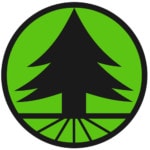
IF YOU NEED AN EMERGENCY TREE REMOVAL,
PLEASE CONTACT US IMMEDIATELY.
The post EMERGENCY TREE REMOVAL IN SAN DIEGO first appeared on San Diego Tree Trimmers – LC Tree Service.
